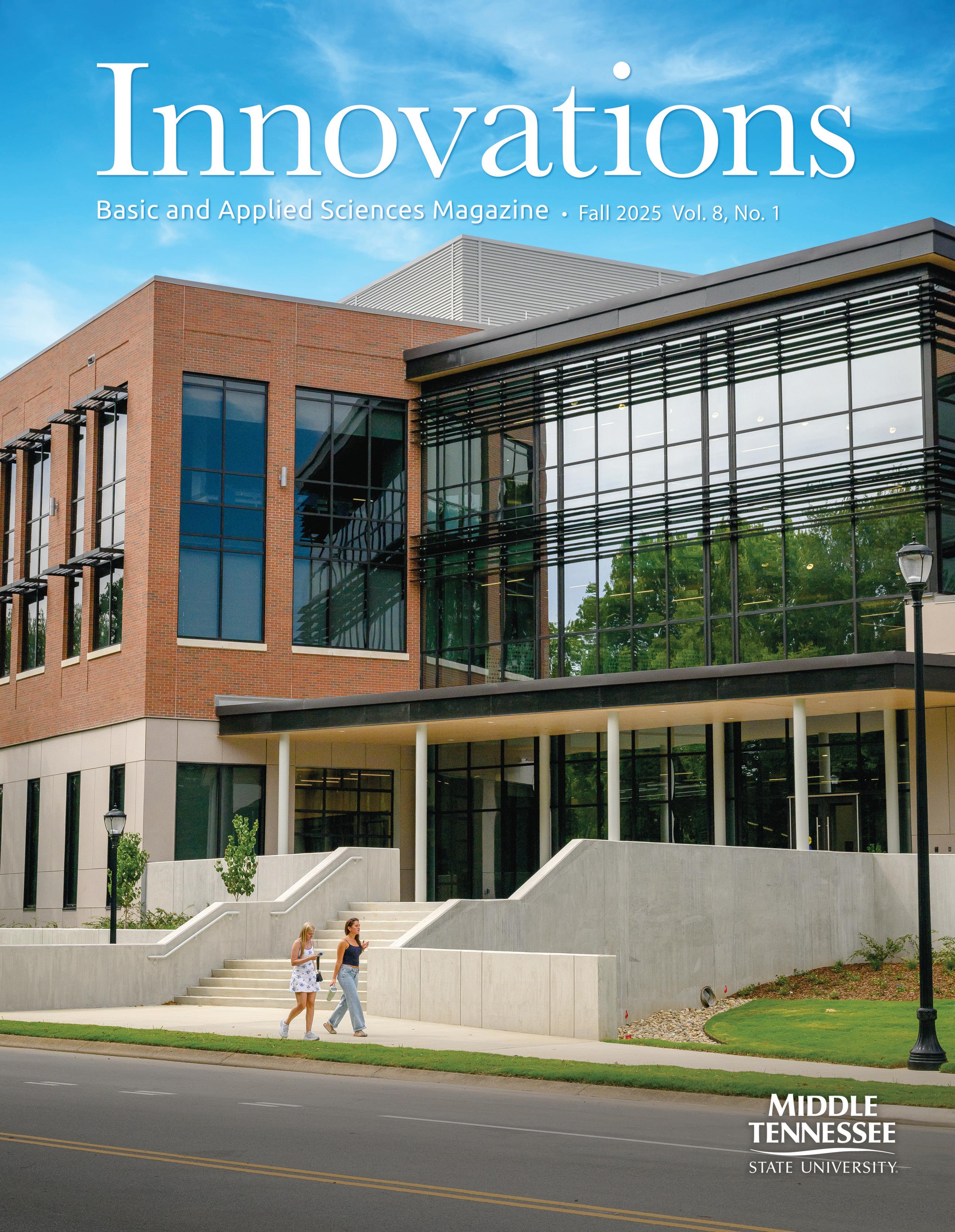

Blueprint for Success
MTSU’s new $74.8 million Applied Engineering Building prepares students for a constantly changing technical world
Dean, College of Basic and Applied Sciences
Greg Van Patten
Strategic Communications Manager, CBAS
Kara Kennedy
Senior Editor
Drew Ruble
Associate Editor
Carol Stuart
Contributing Editor
Nancy Broden
Contributing Writers
Nancy DeGennaro, Jimmy Hart, Robin E. Lee, Karli Sutton, Randy Weiler
Senior Director of Marketing Domeda Duncan
Director of Creative and Visual Services
Kristy O'Neal
Lead Graphic Designer
Brian Evans
Contributing Graphic Designer Micah Loyed
University Photographers
James Cessna, Andy Heidt, J. Intintoli, Cat Curtis Murphy
University President Sidney A. McPhee
University Provost
Mark Byrnes
Vice President, Marketing and Communications Andrew Oppmann
1,660 copies printed at Pollock Printing, Nashville, Tennessee Produced by MTSU Creative and Visual Services
Cover photo by J. Intintoli
Table of Contents


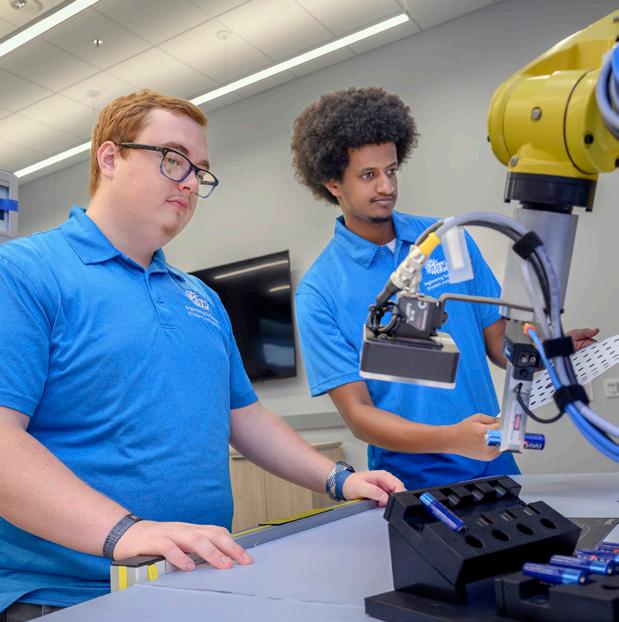
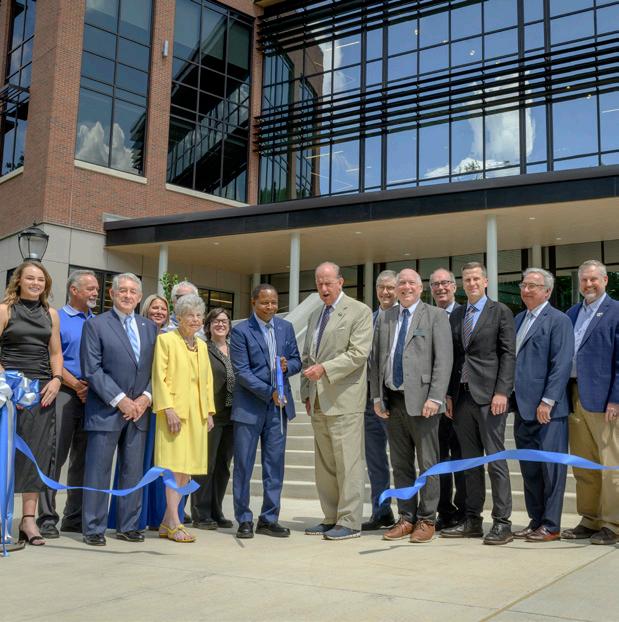

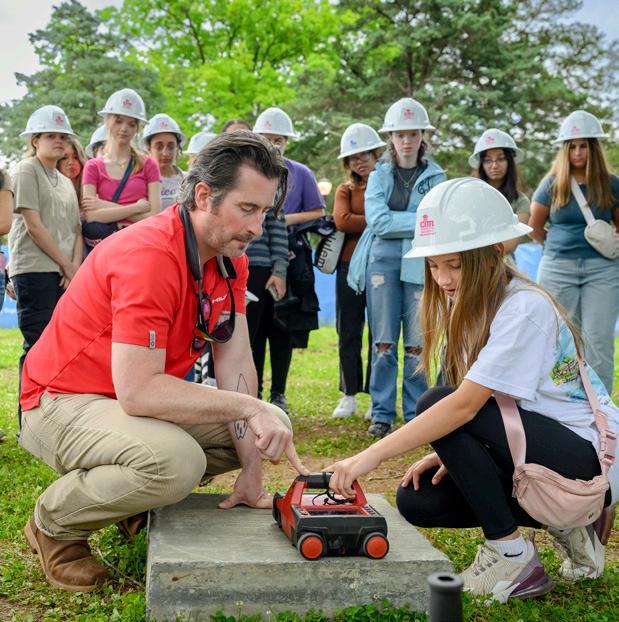




Expanding Opportunities

This fall marks a milestone for MTSU’s College of Basic and Applied Sciences (CBAS) and an inflection point for our Department of Engineering Technology. We officially opened the $74.8 million, 89,000-squarefoot Applied Engineering Building (AEB) in August. This state-of-the-art facility— equipped with millions of dollars’ worth of advanced technology—will forever change the way our students learn and our faculty teach. More than just a new building, it represents an investment in Tennessee’s future workforce and a commitment to innovation in engineering, technology, and advanced manufacturing.
As I walk through the Applied Engineering Building, I am struck by the spacious and modern workspaces and how they will serve students and faculty in ways that were simply not possible in the old Voorhies Engineering Technology Building. The light-filled laboratories, collaborative spaces, and industry-standard equipment reflect the forwardlooking vision of our college and the transformative opportunities we are committed to providing.
As you will see in this issue, the Applied Engineering Building provides world-class laboratories, robotics and automation spaces, and collaborative areas designed to prepare students for the rapidly evolving careers that await them. This remarkable facility also will support the addition of new undergraduate and graduate programs in engineering that are currently under development. The building is the latest addition to our Science Corridor of Innovation, a nexus for cutting-edge research and experiential learning that also includes the MTSU Science Building, School of Concrete and Construction Management Building, Davis Science Building, and Wiser-Patten Science Hall.
The stories in this issue illustrate how CBAS continues to push the frontiers of science and technology across all our departments. You will read about pioneering agricultural research aimed at solving urgent challenges of future food security, breakthroughs in quantum science that position MTSU as a leader in research and workforce development for one of the most transformative technologies of our time, and new discoveries in aerospace engineering that
promise to make aviation even safer. These are just a few examples of how faculty and students in CBAS are making a real impact on the state, the nation, and the world.
As I look to the future, I see tremendous potential for CBAS to build on its strong foundation. In just the past few years, we have more than tripled our external research funding, and this momentum will only grow as we continue to add new facilities and outstanding faculty. We are also expanding our academic programs with purpose and energy—updating our curriculum to reflect the needs of tomorrow’s workforce. In addition to recently launched undergraduate programs in Cybersecurity Systems, Artificial Intelligence, and Quantum Science and Computing, we are preparing to introduce new engineering offerings that will take full advantage of the capabilities provided by the Applied Engineering Building.
WE ARE ALSO EXPANDING OUR ACADEMIC PROGRAMS WITH PURPOSE AND ENERGY— UPDATING OUR CURRICULUM TO REFLECT THE NEEDS OF TOMORROW’S WORKFORCE.
None of this progress would be possible without the steadfast support of our alumni, friends, and partners. Your gifts of time, talent, and treasure are essential to attract outstanding students and faculty, equip our programs with the tools they need to succeed, and expand opportunities for hands-on research and learning. I invite you to visit our campus, tour these remarkable new facilities, and witness for yourself the exciting progress being made every day.
Thank you for being part of our journey. Together, we are shaping the next generation of scientists, engineers, and innovators who will lead Tennessee, and the world, into a brighter future.
With gratitude,

P. Gregory Van Patten Dean, College of Basic and Applied Sciences

MTSU professor Song Cui teams up with a Kansas-based sustainable agriculture agency to prove less tilling tastes great by Drew
Tennessee’s motto is “Agriculture and Commerce.” Agriculture has always been Tennessee’s No. 1 industry and synonymous with its brand.
Food grown in the Volunteer State is planted in carbon-rich topsoil. But topsoil is disappearing at a terrifying rate across the United States. According to a study by Cornell University, almost 2 billion tons of farmland are lost to soil erosion every year. From a food supply standpoint, it’s nothing short of a crisis.
Tennessee farmers boast a proud history of employing conservation methods to reduce the erosion of topsoil across the state. That’s one of many reasons the nonprofit Land Institute, based in Salina, Kansas, has its eye on Tennessee. Through the selective breeding of seeds and the development of perennial grain crops that don’t need replanting annually, the Land Institute is a national leader in ecologically sensitive agriculture.


Now, as a result of a recent partnership between the institute and MTSU Agriculture professor and researcher Song Cui, perennial plants like grain, sorghum, and sunflowers are being tested in Tennessee soil.
It’s creating new opportunities for Tennessee farmers.
Ruble
Song Cui
A WILLING PARTNER
Perennial grains like those the Land Institute pioneered grow long roots that extend deep into the ground.
By doing so, they build healthy soil, better absorb water, protect soil from erosion, retain nutrients, foster biodiversity, and remove carbon dioxide from the air.
The Land Institute’s signature product to date is Kernza, a perennial grain it developed, which flourishes in the Midwestern U.S.
Kernza produces a grain yield for about three years—a significant improvement over annual crops requiring tilling each year.
Major food manufacturers like General Mills and supermarket chains such as Whole Foods are already deep in the Kernza business. Consumers nationwide can easily find Kernza products, including beer, on grocery store shelves.
That commercial success is crucial. Because it’s not enough that a product is supported by consumers with an ecologically friendly mindset. Pragmatically
speaking, to truly dent the market and bring about change, it also has to taste good, and farmers have to be able to make money growing it.
Ebony Murrell, crop protection ecologist at the Land Institute, said her organization is very proud of Kernza’s market success. It remains the institute’s most successful grain to date.
KERNZA
PRODUCES A GRAIN YIELD
FOR ABOUT THREE
YEARS— A SIGNIFICANT
IMPROVEMENT
OVER ANNUAL CROPS REQUIRING TILLING EACH YEAR.
Murrell and her colleagues at Land Institute are working on other perennial grains, including perennial sorghum, a hybrid between annual sorghum and Johnson grass, which is a weed, and silflower, a prairie grass that is a cousin to the annual sunflower.
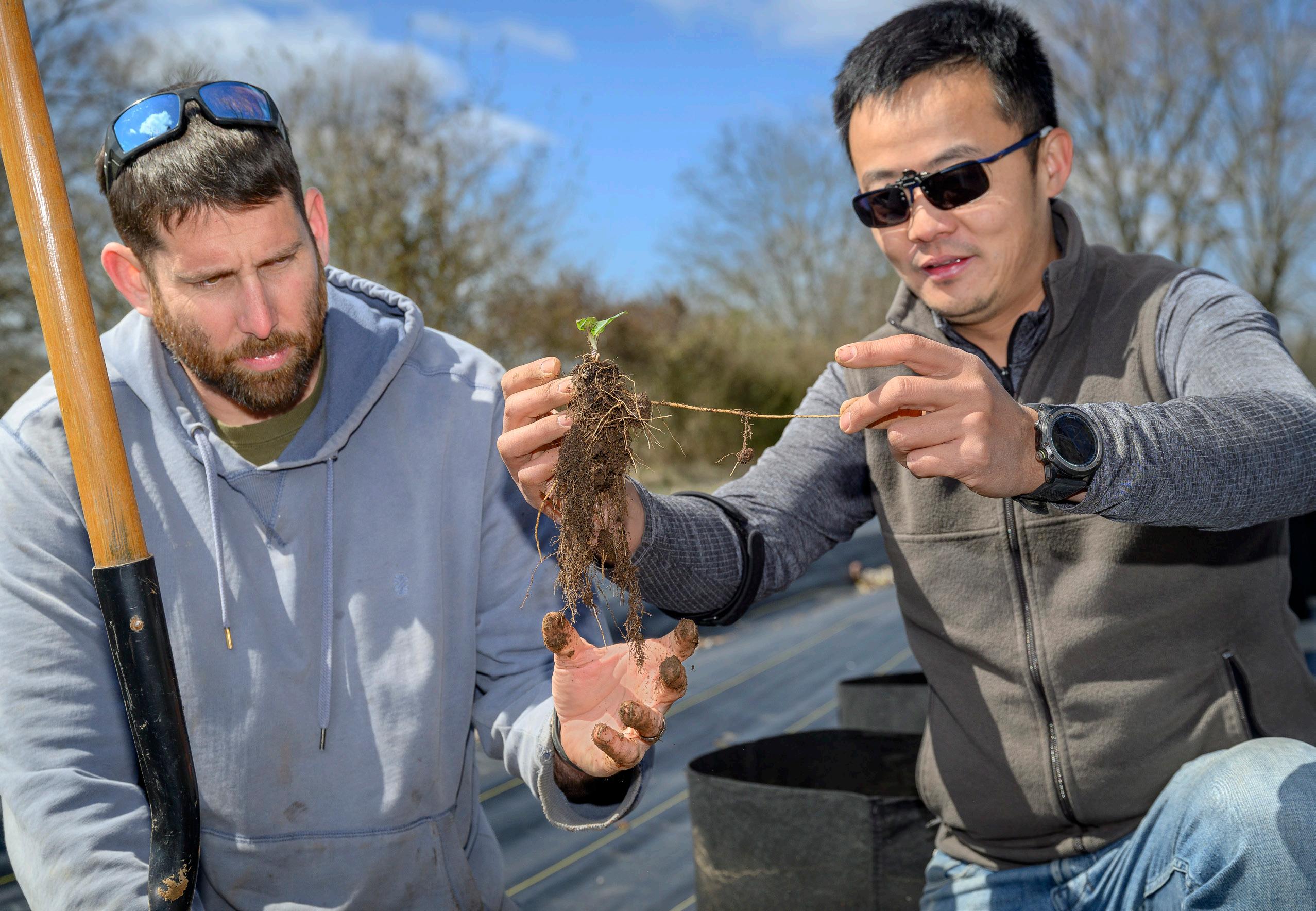
MTSU’s Cui (r) showing perennial sunflower roots
The question for the institute now is: Can Kernza (and other perennial crops) viably grow in other parts of the country and world?
To that end, Land Institute has launched a movement to scale perennial agriculture, building connections to ensure that perennial grains will be developed on every continent except Antarctica.
In doing so, it supports more than 200 researchers in more than 30 countries.
DIGGING INTO THE DETAILS
Enter Cui, who became a partner to investigate some of the institute’s lines in plant breeding in Tennessee last year.
“They might be shooting for higher yield, better adaptivity, adaptivity to a new environment, a lot of things,” Cui said of the institute’s interest in MTSU and farming in Tennessee. “So, that’s the way I started a conversation with them. They told me what they need, and I offered whatever we can do here. They have varieties of breeding lines that no one has ever grown in the Southeastern United States. Now we are!”
Kernza, sorghum, and silflower are the three crops currently associated with the MTSU grant. (Land Institute is testing wheat and lentil products elsewhere.)
Murrell said the institute is thrilled to be partnering with Cui and MTSU and to spread perennial agriculture to the South.
“We are excited about bringing in a lot of these novel cover crops and cropping rotations and intercropping to institutions across the South and Southeastern U.S. that historically don’t get nearly as much love or as much attention for their sustainable agriculture practices,” Murrell said. “And I’m delighted that Song is really making a strong effort to do this.”
Cui most recently planted Kernza in November 2024. Their roots are huge and very deep—at least 3 or 4 feet.
Cui also planted about 600 perennial sunflowers, as well as perennial sorghum,

A WORLDWIDE EFFORT
A group of 153 Nobel and World Food Prize laureates wrote a letter in 2025 calling for significant political and financial support for “moonshot” initiatives to meet the food needs of a growing planet and support the long-term health of the planet.
The letter’s authors noted the need for concentrated investments in agricultural research and development to address variable and unpredictable weather, declining food yields, soil and land degradation, natural resource scarcity, and biodiversity loss.
To rectify these agricultural and environmental concerns, the authors reference the urgency for several moonshot initiatives, including a perennial agriculture transformation and an emphasis on new crop development for nitrogen fixation and diverse cropping systems at the global scale.
“We are advocating for transformational efforts across the food value chain, from inputs to production to the post-harvest phase. Building on recent advancements in biology and genetics, moonshot initiatives that could be considered include: enhancement of photosynthesis in crops such as wheat and rice, biological nitrogen fixation of major cereals, transformation of annual to perennial crops, development of new and overlooked crops, innovations in diverse cropping systems, enhancement of fruits and vegetables to improve storage and shelf life and to increase food safety, and the creation of nutrient-rich food from microorganisms and fungi,” the letter read.
The Land Institute in Salina, Kansas, a science-based research organization working to develop an alternative to current destructive agricultural practices, is dedicated to advancing perennial grain crops and polyculture farming solutions. The institute and MTSU are currently working together on a series of grants related to perennial crops.
last summer. In addition to his research, all crops are used for teaching purposes.
“You’re looking about almost zero management,” Cui said. “It’s one time planting and getting them established, maybe some weeding at the very beginning, but then they kind of take care of themselves.”
That’s a far cry from traditional agricultural methods, which Cui describes as an ecologist’s nightmare. Each time a farmer tills the soil, about 40% of the carbon in it is emitted out into the air. Tilling also requires the use of fossil fuels to power it.
“Then, at the end of the year, you’re going to have to harvest, and you’re going to have to do something about the field again,” Cui said. “You either have to plant a different cover crop, or you just leave it, releasing all the carbon. Then, the next year, the cycle begins again.”
By comparison, with a perennial system in place, once established well, “you don't have to do anything for years,” Cui said. That’s because the root depths on the perennial grains are about 10 to 20 times deeper than typical annual crops. “And those roots are where the carbon goes. That's the other benefit.”

MAKING THE CASE
Cui’s early success with perennial plants is creating buzz in the Tennessee farm community.
“Tennessee farmers are interested in growing these,” he said. “The interest out there is just huge. As soon as I start talking about perennial sunflowers, people start talking to me and calling me. They’ll say, ‘Hey, can I have some seeds? I want to grow it.’
“We must try to achieve a better future, a more sustainable farming future, for the nation. That’s kind of the bigger picture of all the projects we’ve been working on.”
THE INSTITUTE IS THRILLED TO BE PARTNERING WITH CUI AND MTSU TO SPREAD PERENNIAL AGRICULTURE TO THE SOUTH.
According to Cui, the Land Institute’s interest in MTSU extends beyond his specific project. Other MTSU Agriculture programs the institute has pegged for potential future research endeavors include the Fermentation Science program and the Tennessee Center for Botanical Medicine Research.
“They value us as an institution,” Cui said, “and we all work together very closely. That’s the part they really love.
“Other than just growing perennial crops, they like the fact that we can explore the value of it. Is there a better use of it than solely for producing greens for human consumption? Maybe there are medicinal properties. Maybe there is value in the oils. Can you make good wines or sake out of it? Actually, we have preliminary data already supported that says, ‘Yes, you can! You can do all sort of things with it!’”
The School of Agriculture’s facilities include several farms, a dairy, four greenhouses, a fermentation lab, and the Horse Science Center. Students in the department apply what they learn in a variety of real-life settings.
MTSU Agriculture faculty teach that feeding the world in a sustainable way is key to the future, and its students participate in research and experiential learning that progress toward that goal.
The new partnership on perennial crop production is just the next step.
Sunflowers during a Tennessee winter

Kernza roots at the MTSU
MTSU
and professor Hanna
Terletska lead research and training efforts to prepare workforce for the future of computing
by Drew Ruble

Say the word “quantum,” and the average person might conjure up images of time travel, à la the television show Quantum Leap from the 1990s.
Told of quantum initiatives now taking place on the campus of MTSU, they might envision a portal tucked away somewhere in a basement lab where researchers disappear and reappear at random intervals.
Spoiler alert: That’s not happening.
FORWARD

The future of quantum computing is indeed the stuff of fantasy and science fiction. And MTSU researcher Hanna Terletska, leader of MTSU’s Quantum Science Initiative and an associate professor of Physics, is doggedly pursuing it. In her research funded by $5.5 million from the National Science Foundation (NSF) and Department of Energy (DOE), Terletska collaborates with scholars from places like Carnegie Mellon University, Oak Ridge National Laboratory (ORNL), and Augsburg University
in Germany, using access to the world’s most powerful computers to research quantum materials that hold the promise of new-generation technologies that actually do mimic time travel—or, at least, particles reacting simultaneously in two places at once.
But MTSU’s quantum focus is not only about scientific breakthroughs but also teaching the science. Perfectly aligned with its original charter as a teacher training


school founded in 1911, MTSU has positioned itself as the statewide leader in preparing a “ready-towork” workforce for an inevitable future where quantum science and computing revolutionizes industries as far ranging as health care to cybersecurity.
MTSU is also becoming a national leader in training teachers how to teach quantum physics, a crucial educational component in the quest to fully realize quantum’s potential, with Terletska leading national training sessions in quantum.
From Theory to Practice
Terletska describes the discovery of new materials as “a cornerstone of human civilization and development.”
“We now live in the era of quantum materials,” she said. “The potential benefits of 21st-century technologies built on quantum materials and emerging quantum technologies are staggering.”
This includes quantum computers capable of solving complex problems in minutes, problems that currently take years to solve, as well as highly efficient solar cells and room-temperature superconductors that would generate, transmit, and store electricity with almost no loss. Hence, conquering the behavior of quantum materials can, among other benefits, bolster economies, advance quality of life, and address the unprecedented growth in global energy needs. Wired magazine once succinctly described that quantum computing “is about chasing perhaps the biggest performance boost in the history of technology. The basic idea is to smash some barriers that limit the speed of existing computers by harnessing the counterintuitive physics of subatomic scales.”
The seeming “magic” of quantum materials comes from billions of interacting electrons, which at the atomic and subatomic levels start to also
have wavelike properties. At this level, quantum physics really kicks in, and electrons start to exhibit quantum effects like tunneling, interference, entanglement, and topological order. Research in this field requires complex many-body numerical algorithms and access to powerful supercomputers.
Admittedly, at present, a lot of this is still theory. There is a race going on to create the physical processor that’s eventually going to make this type of computing possible. Companies like Microsoft, Google, and IBM are investing big in quantum technology, and announcing major breakthroughs seemingly every month. Founder and lead of Google Quantum AI Hartmut Neven stated recently that his company is “optimistic that within five years we’ll see real-world applications that are possible only on quantum computers.”
Suffice it to say, it’s coming. And when it does, it will turn established ways of doing things into primitive history. But getting from science fiction and fantasy to this new reality requires reinterpreting the math and learning new physics. It also requires teaching it to a new generation of scholars.
The future of quantum computing is indeed the stuff of fantasy and science fiction.
That’s where Terletska and MTSU enter the picture.
“We need to educate people how to use it,” said MTSU College of Basic and Applied Sciences Dean Greg Van Patten. “We need to educate people on basically a new type of science—the basic rules of quantum mechanics that lead us to be able to do this kind of processing.”
To bring about this needed change in curriculum, MTSU in 2023 launched the MTSU Quantum Science Initiative, which not only focuses on remaining at the forefront of the scientific research in quantum materials and quantum information but also outlines two other goals: 1) educating a future workforce ready to tackle the new realities of computing and 2) becoming a leader at “training the trainers” so other institutions can fast-track the teaching of this new-age thinking.
That starts with creating a curriculum for teaching quantum mechanics and computing. The work is interdisciplinary in nature, growing out of

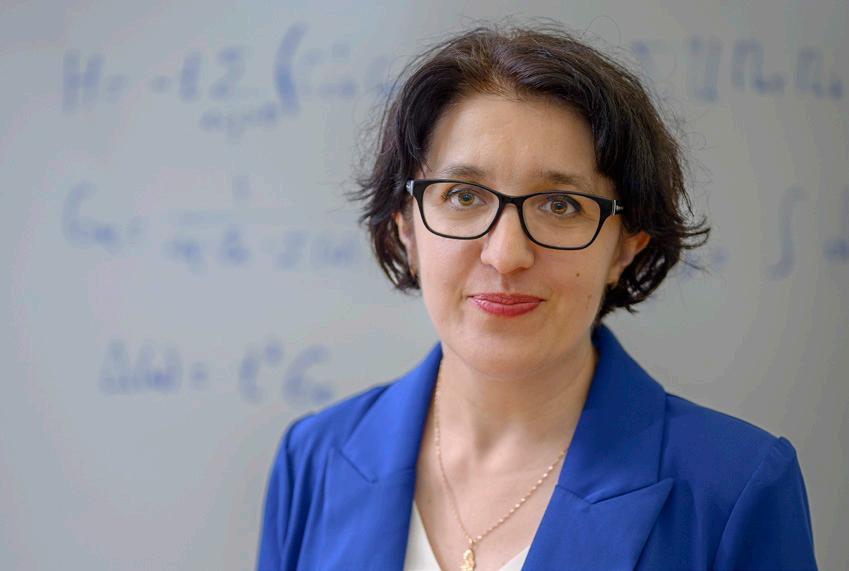
Home Schooled
Originally from the Drohobych, Lviv, region of Ukraine, Hanna Terletska is a firstgeneration college student who has not forgotten her roots.
Terletska—who earned her M.S. at Minnesota State, then a Ph.D. at Florida State University, followed by several postdoctoral trainings at the Brookhaven National Lab, Louisiana State University, Ames Lab, and University of Michigan, and finally the faculty position at MTSU in 2017—recently launched the STEM with UKRAINE Initiative, partnering with Ukrainian and American universities and institutions to bring and sustain quantum computing education for an international population under the burden of an ongoing war with Russia.
Since its inception, the partnership grew to include 29 Ukrainian universities and institutions, 10 U.S. institutions, and one Canadian university and successfully guided 100 participants—coming from an array of academic backgrounds and countries such as Canada, China, India, Italy, Ukraine, and the U.S.—to earning completion certificates at the end of May 2024.
The initiative is part of Terletska’s larger $800,000 National Science Foundation “ExpandQISE” grant, which she explained aims “to open up access to quantum training to all interested in quantum, welcoming participants from diverse educational backgrounds and levels of expertise, including high school teachers and seasoned faculty members, to a rich exchange of ideas and perspectives.”

CBAS Dean
Greg Van Patten

physics where these quantum concepts were discovered, but branching into computer science, mathematical sciences, and even chemistry.
It wasn’t long ago that there was no roadmap for how to educate students in this field. Academics like Terletska have changed all that. At MTSU, Terletska developed educational materials to bring students from “ground zero” and start educating them about quantum mechanics.
It placed her in the national spotlight.
“Her work in this field has been a big deal,” Van Patten said. “She did some preliminary work here, and then, based on that work and her ideas, was granted in 2020 a nearly $500,000 Early Career Development CAREER grant from the National Science Foundation—a highly respected five-year award that most often only go to junior faculty at top-tiered research institutions. . . . That’s a marker very early on in somebody’s career that they are poised to be a leader. And that’s the federal government investing in them as a leader.”
At present, quantum science is a rapidly advancing field that is beginning its transition from the laboratory to the marketplace.
Not resting on those high laurels, Terletska used her newfound attention and resources to accelerate collaborations and ensure her research and awards resulted in the education of the next generation of scientists. For starters, along with Professor Ron Henderson, head of the MTSU Physics and Astronomy Department, she built the University’s Quantum Science and Computing concentration in Physics that began in fall 2024.
“Before Hanna came to MTSU, there was no mention of quantum science outside of two courses taught in physics,” Henderson said about
Terletska’s arrival in 2017. “There is significant national interest in quantum computing, but the expertise required to contribute in this area of research is beyond the training of most faculty. Hanna took the initiative to expand her knowledge from quantum mechanics and quantum materials to quantum computing.”
Terletska has also conducted numerous “train the trainer” seminars (see accompanying sidebar ) so that the information she’s producing reaches K–12 teachers who can start preparing students with these ideas early on. And she’s provided her materials and made them available to other universities and colleges. She developed plans to create a center for quantum studies at MTSU, and her latest DOE grant proposal envisions a collaboration on quantum material research with other universities in middle Tennessee and to produce a workforce specifically aimed at supporting labs like Oak Ridge, where they need this kind of technical training that otherwise is not yet available.
The Race Is On
MTSU is currently seeking state dollars to support its Quantum Initiative. Its pitch is that the University’s strong efforts in workforce development and teacher education perfectly complement other quantum efforts now occurring at other universities in the state.
The nearby University of Tennessee–Chattanooga (UTC) has already benefitted from a significant investment made by the state of Tennessee, as well as from the city of Chattanooga. The University of Tennessee system also boasts the Appalachian Quantum Initiative. But MTSU has reached a critical mass with nine federal grants worth $8.8 million already that additional state support could further build upon to expand quantum efforts in Tennessee. MTSU is poised to make even bigger contributions in other needed pillars of quantum investment, with strengths already in quantum algorithms and quantum materials along with the aforementioned creation of a quantum workforce development and training program—aka, the education piece.
Van Patten said only when all of these moving parts work together can the state of Tennessee truly become a national leader on this most groundbreaking scientific advancement in modern history.
Van Patten has put his college’s money where his mouth is, investing precious (and limited)

University capital in the MTSU Quantum Science Initiative. So too has the MTSU Provost’s Office, which has committed significant funding to the initiative. Regarding outside investment, Terletska alone has garnered $5.5 million from seven grants in recent years, almost all of her funding sources reflecting federal investment.
But more is needed to ensure Tennessee capitalizes on its quantum head start. As such, MTSU has requested additional funding and support from the state.
“We are asking the state to recognize this leadership position and to invest in it,” Van Patten said. “We think it’s going to be great for the state of Tennessee. We think it’s going to position Tennessee as a leader in the region for quantum . . . drive the state’s economy, and drive Tennessee forward.”
Governments and large multinational companies around the world have launched significant quantum material research initiatives in recent years and have invested heavily in related technologies and education. In 2018, the U.S. government signed a Quantum Initiative Act, making quantum material research a national priority. Over the last decade, numerous quantum research centers have emerged all across the U.S.
“If we want America to be the first to explore and understand the quantum-scale frontiers of science, then we must support the excellence that exists at institutions all over our country,” said Sean L. Jones, NSF assistant director for mathematical and physical sciences. “NSF’s support for these new projects demonstrates our commitment to nurturing innovative ideas and people, wherever they are.”
Van Patten said the ongoing research on quantum materials, education, and information science at MTSU not only underscores that national priority but squarely hits all three parts of his college’s mission: preparing students at all levels for successful careers across a range of scientific and technical fields, promoting scholarship and scientific inquiry, and addressing key scientific challenges that face our nation.
“At present, quantum science is a rapidly advancing field that is beginning its transition from the laboratory to the marketplace. It has the potential to revolutionize certain computational tasks, including cybersecurity, and I’m excited that MTSU is involved in moving this field forward,” he said.
MTSU clearly wants and deserves a bigger piece of the action. Now classified by Carnegie as an R2 research university, characterized by “high research spending and doctorate production”—a recognition earned by only 3% of colleges and universities nationwide—MTSU is ready and able to expand its expertise in quantum sciences. With clear goals, a solid foundation, and a national leader in Terletska leading the charge, MTSU is also poised to help the state of Tennessee make a giant leap forward.
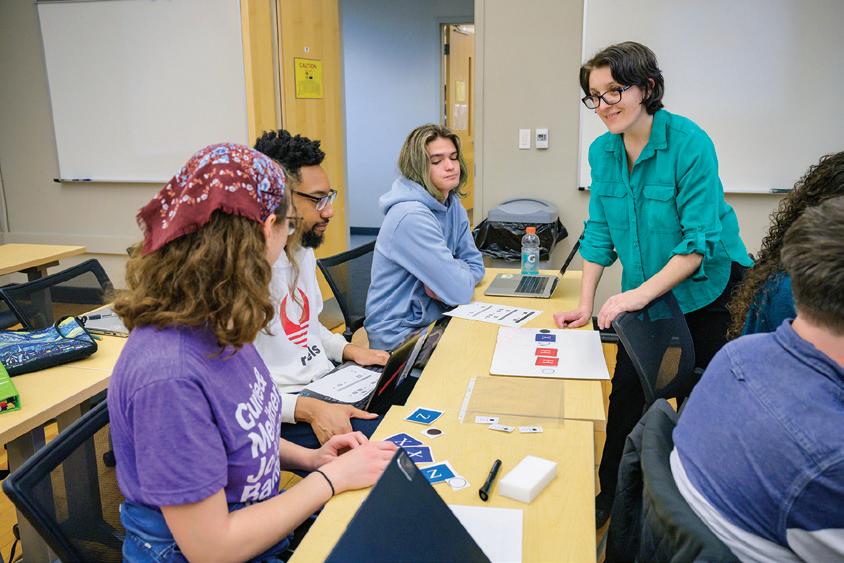
Training the Trainers
At the American Association of Physics
Teachers winter 2025 meeting in St. Louis in mid-January, MTSU’s Hanna Terletska— along with Stewarts Creek High School teacher Robert Haddard (’14, B.S.; ’25, Ph.D.) and MTSU Department of Physics and Astronomy scholar and researcher Paulson K. George—led a successful workshop, “Train the Trainer: From Atoms to Quantum Computers.”
The four-hour session provided essential guidance on how to introduce quantum mechanics and quantum computing concepts to high school educators. This workshop was also part of Terletska’s efforts under her National Science Foundation-funded (three-year $800,000) ExpandQISE award.
The workshop attracted participants from Stony Brook University, Purdue University, the University of Denver, University of Tennessee–Chattanooga, and others.
Terletska, an MTSU associate professor in Physics, has led numerous pioneering quantum education initiatives, including STEM camps in 2023–24 for approximately 65 high school students, equipping them with fundamental quantum skills and exposure to cutting-edge quantum technologies.
She also conducted the train the trainer workshop when MTSU hosted the Tennessee section of the American Association of Physics Teachers in spring 2024, engaging faculty representatives from Christian Brothers University, the University of Tennessee, UTC, Tennessee Tech, and Austin Peay State University.
MTSU’s new $74.8 million Applied Engineering Building prepares students for a constantly changing technical world
Explosive growth in programs, especially Mechatronics Engineering, was central to the University’s decision to build a $74.8 million, 89,000-square-foot Applied Engineering Building (AEB).
The AEB, home to the Engineering Technology Department, opened on the southeast side of campus in August. It sits next to the School of Concrete and Construction Management, a $40.1 million, 54,000-square-foot facility that opened three years previously.
“This is another state-of-the-art facility that puts the finishing touches on our Science Corridor of Innovation,” said MTSU President Sidney A. McPhee. The corridor includes the MTSU Science Building opened in 2014, as well as pre-existing science facilities on campus.
“We are committed to providing our students with the latest, cutting-edge technology and resources to ensure they’re well prepared for the in-demand jobs this facility will train them to do.”
College of Basic and Applied Sciences Dean Greg Van Patten said the AEB “represents a new phase in the life of the department—a progression into a new era of possibilities for our faculty and students.”

In addition to the renowned Mechatronics Engineering program, the department offers a major in Engineering Technology with three concentrations—Computer Engineering Technology, Electromechanical Engineering Technology, and Mechanical Engineering Technology. Features in the new building include a Makerspace area, new robotics equipment, and industry-inspired automation and fabrication labs.
Nearly $1.2 million in equipment has been donated or purchased for the new building, including gifts from generous corporate supporters Dexcom and Automation Nth that will help bridge the gap between industry and education. This includes 10 Flexbase automation work centers from Dexcom valued at almost $920,000. The units were sold to Dexcom by La Vergne-based Automation Nth, which committed more than $100,000 in supplies and services to upgrade the units—integrated work cells with robotics, vision systems, and controls. These two companies are showcased in the new building with the 2,000-square-foot Dexcom Automation Laboratory and 500-square-foot Automation Nth Vision Systems Lab.
by Drew Ruble and Randy Weiler
Photos by Andy Heidt and J. Intintoli

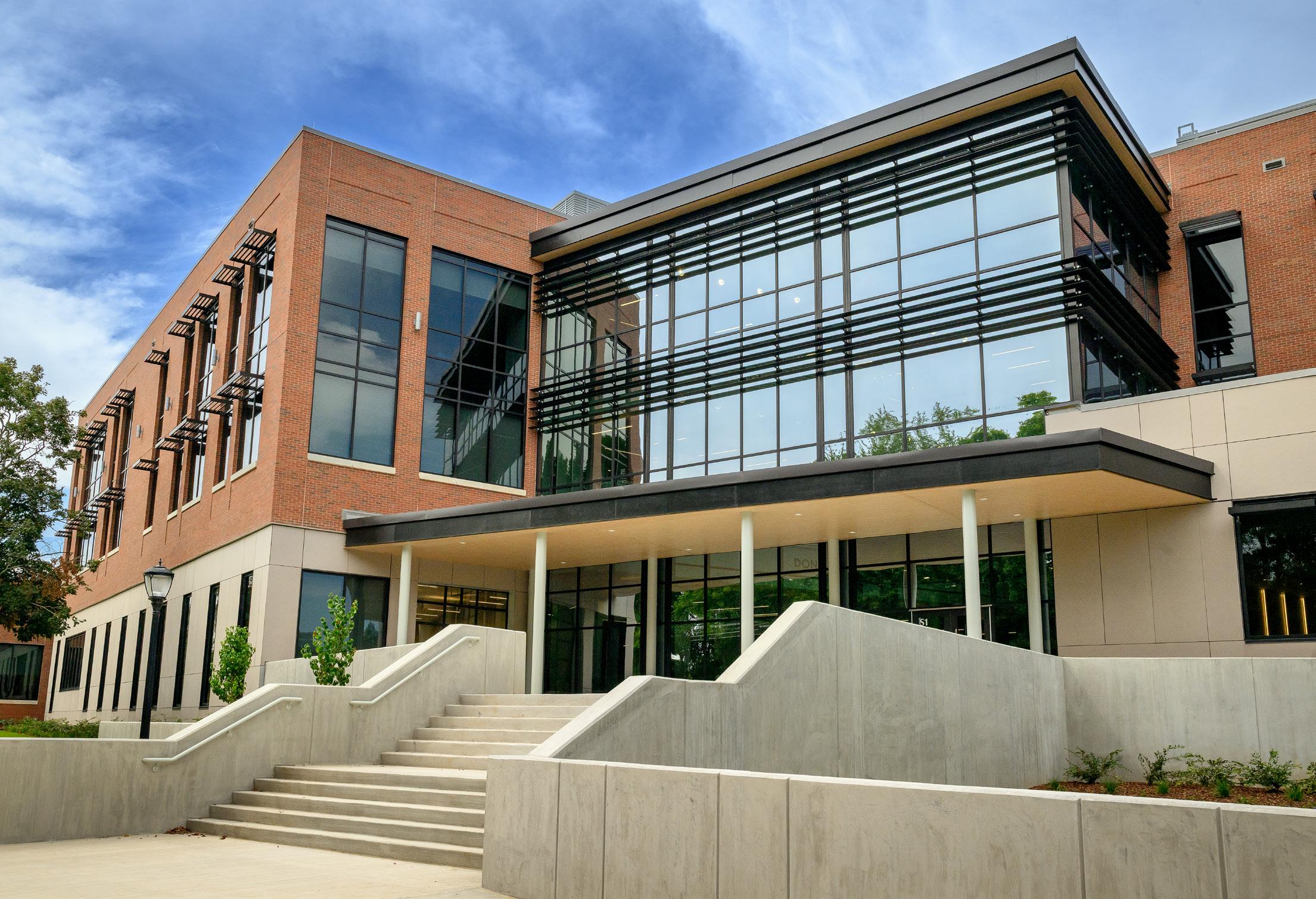



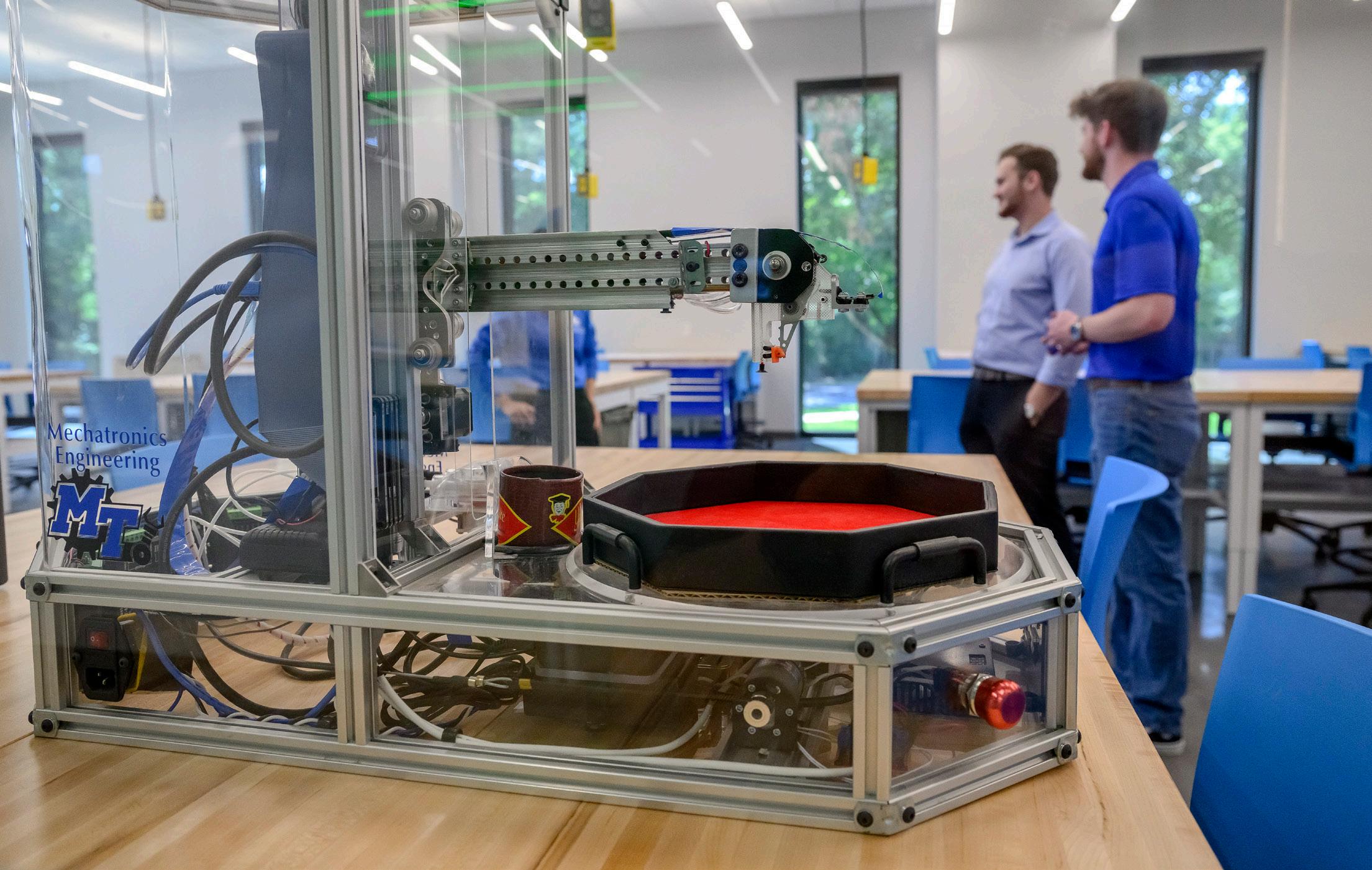
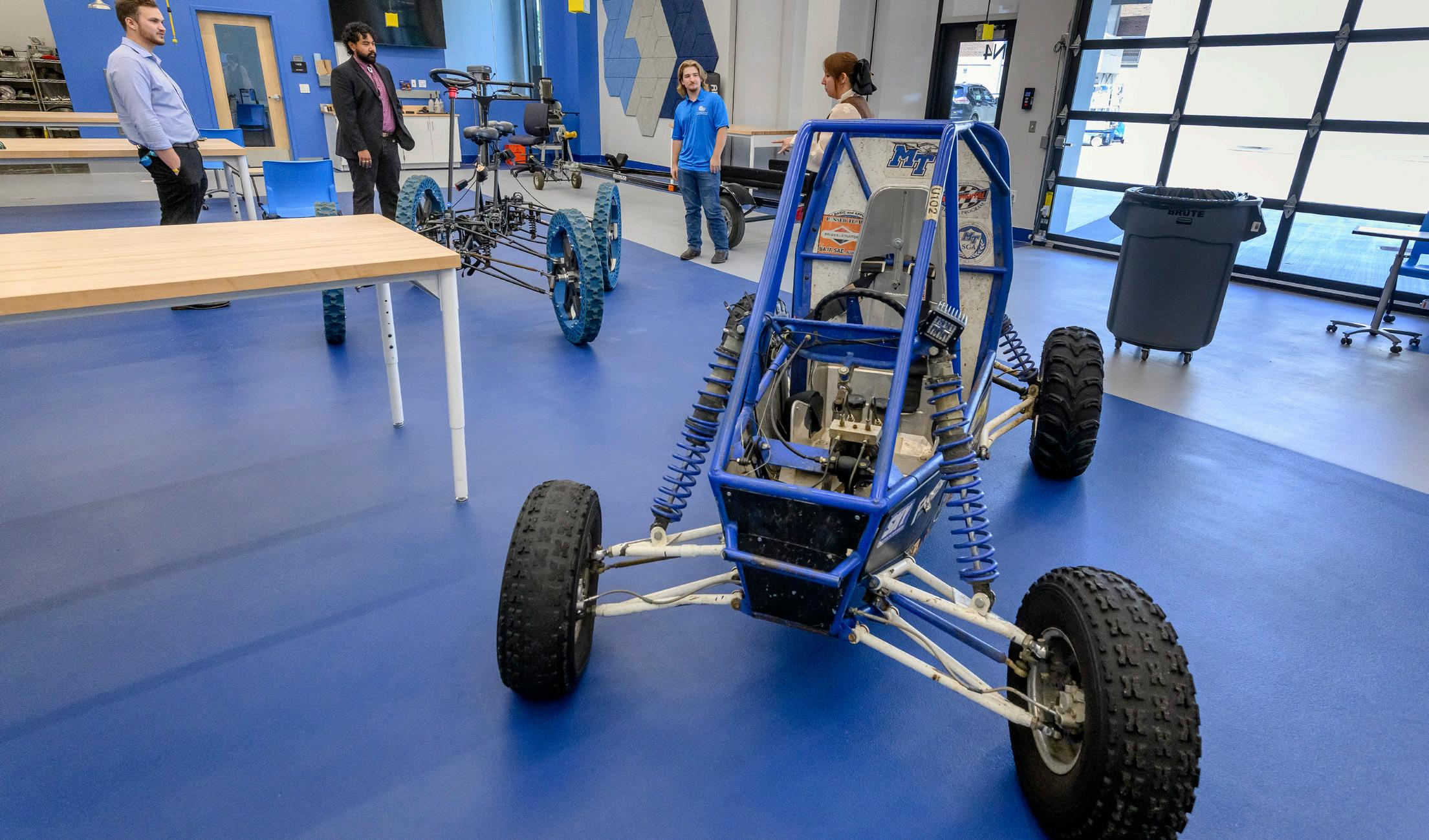


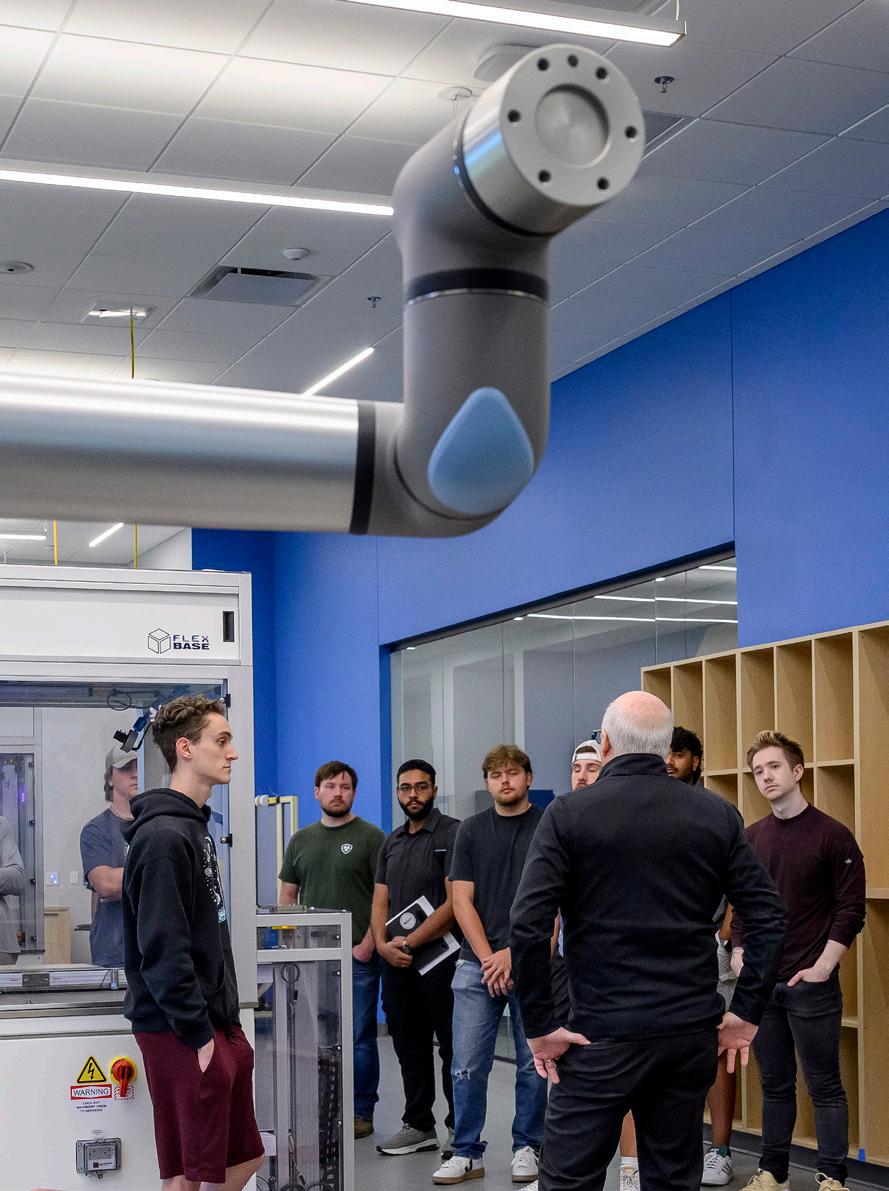
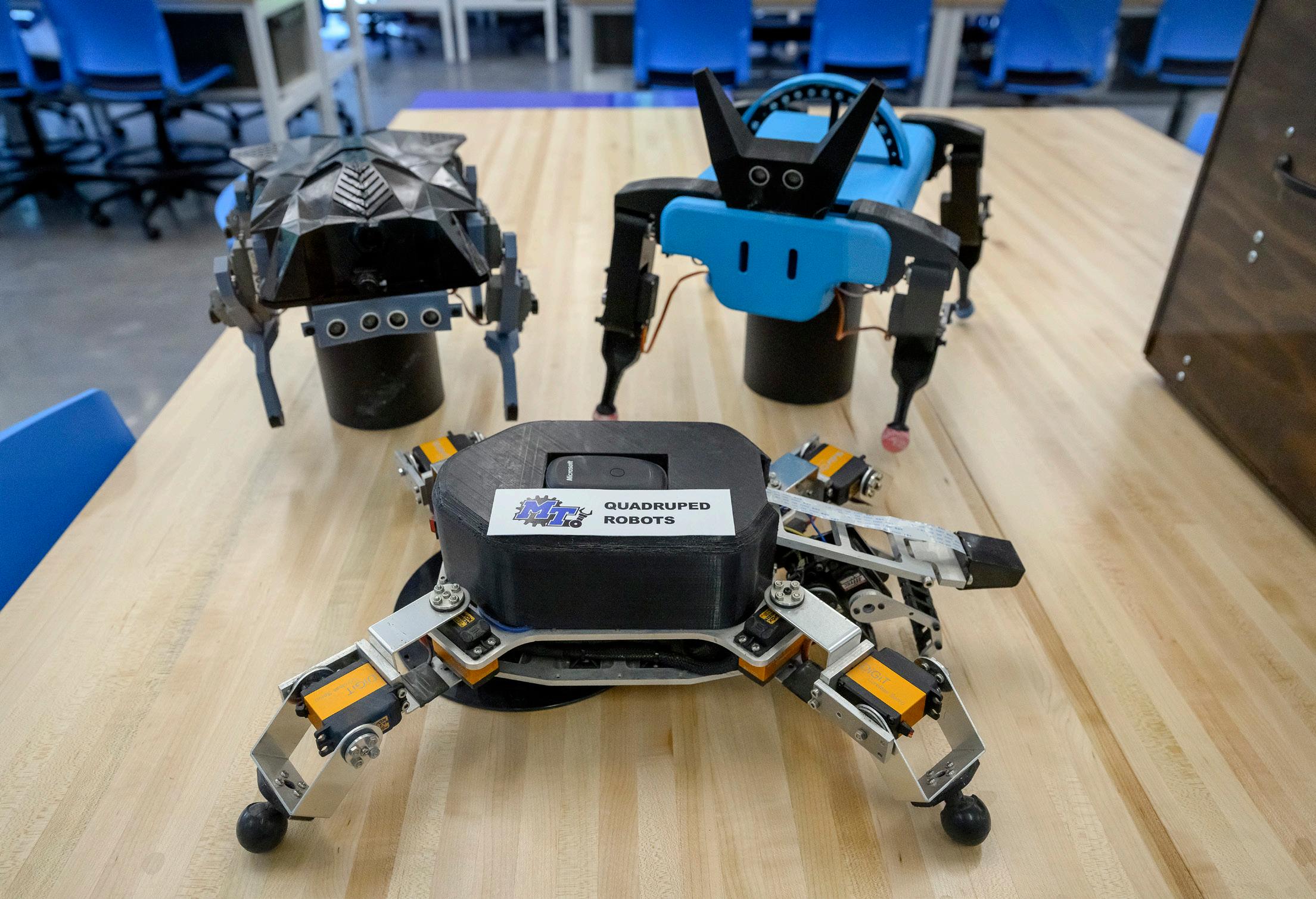
DONOR GIFTS POWER MTSU’S NEW APPLIED ENGINEERING BUILDING
by Brian Delaney
Philanthropy helped lay the foundation for the new Applied Engineering Building (AEB), which stands not only as a hub for innovation but also as a testament to the generosity and vision of devoted donors.
Two families, in particular, helped transform this high-tech dream into reality: the McDonalds and the Goulds. Their legacy is now shaping the next generation of engineering leaders.
For students like Max Brooks, a Mechatronics Engineering major, the donor support and corporate partnerships for the Engineering Technology Department make MTSU stand out.
“It’s wonderful that so many people are invested in making a better experience for our engineering student community,” Brooks said. “I originally came to MTSU because it had the mechatronics major I wanted—and I knew this new building would be completed during my time here.”
Brooks said he sees the impact of donors every time he walks through the new facility.
“Whether it’s the welcoming atrium provided by the McDonalds or the advanced laboratory provided by Dr. Gould’s family, I feel the same glimmers of energy I did as a freshman, where the department truly wants me to succeed,” he said.
A LIFETIME OF SERVICE, A LASTING LEGACY
From a Rutherford County farm in the Blackman community to MTSU and beyond, Donald McDonald has built his life on education and hard work. Now, he and his wife, Frances, are ensuring future generations of students can do the same.
Most recently, the couple made a major gift to the new AEB. Its central gathering space now bears their names: the Donald and Frances McDonald Atrium.
With his roots in the engineering program, Donald McDonald was drawn to the facility’s potential. He saw early renderings of the AEB while working with MTSU’s Development Office. The project inspired a way to create a lasting legacy while helping students succeed for generations to come.
The McDonalds, who celebrated their 60th wedding anniversary in 2025, have a long history of giving back. In 2004, they created an endowed scholarship for students in Engineering Technology and Aerospace. Donald’s own story, as a “farm boy” with limited options to afford college, shaped that decision. “We decided to help students like myself, that didn’t have a lot of funds to start with,” he said.
His deep affinity for MTSU also stems from the faculty who supported him during his formative years as a student.

“The best thing was the mentorship that the instructors gave,” he recalled. “All four years, they were mentors in each of their fields. I can name every one of them. And they tried to help you learn what you needed after you got out of school. And these guys were personable. They were really nice to me, and I’ll always remember that.”
Two mentors stood out. Harold Jewell, the superintendent of buildings and grounds, gave Donald a campus job as a craftsman drafting parking lots. And woodworking shop instructor Philip Dalton left an impression with his philosophical musings.
“[Dalton] would come back while I was working on my projects, and he’d want to talk international politics and this and that and the other. And I finally told him, I said, ‘Mr. Dalton, if you don’t let me work on this project, I’m not going get it finished,’ ” Donald recalled with a laugh.
That on-campus job, Donald said, helped him earn the money he needed to support his education.
Donald’s path to graduation wasn’t straightforward— he had to pause his education in the late 1950s due to finances. He made a strategic pivot to join the U.S. Navy’s flight school to pursue his interest in aviation, then returned to MTSU to complete his degree in 1963.
He went on to a long career at Middle Tennessee Electric Membership Corporation, retiring as director of operations in 1999.
Donald and Frances deepened their support of Aerospace with support to create the McDonald Aerospace Maintenance Laboratory in 2018. Donald also served on the MTSU Foundation board for six years, continues to serve on the Aerospace advisory
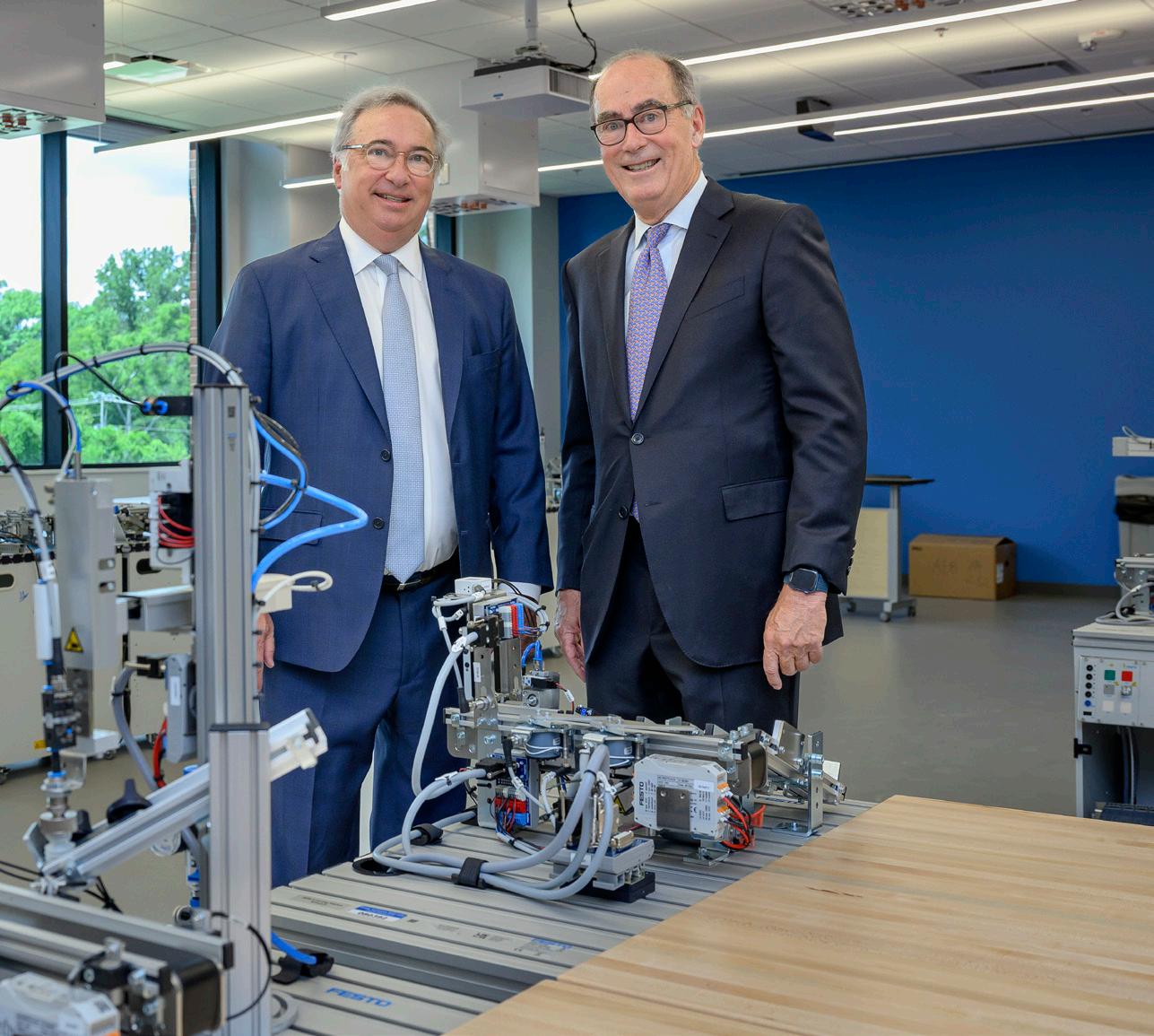
board, and was celebrated in 2014 with the MTSU Alumni Association’s David Cullum Award for Service to the University.
Although Frances did not attend MTSU, she has always been a steady partner in their shared vision. “I’m just always supporting Don in these decisions,” she said. She also built her own career, working more than 30 years in accounting for engineering firms in Nashville.
“We felt for a lot of kids that we saw with potential,” Donald said. “With the right training, you could make a great career. And that’s what we decided would be the best type of [scholarship recipient].”
Today, the McDonalds’ generosity continues to open doors for students like Aidan Martin, a Mechatronics Engineering major and department scholarship recipient.
“The McDonalds’ philanthropy has helped me go through university without worrying about the money involved,” Martin said.
Based in the Smart Sensing and Robotics Lab, Martin helped design a six-wheeled autonomous robot for agriculture. “MTSU is going to be a superpower in middle Tennessee,” said Martin, who anticipates graduating in 2027. “This new frontier for AI and automation can now be accessed by the students here.”
A VISION FOR MECHATRONICS AND BEYOND
The Gould family’s support for MTSU Engineering Technology began with the creation in 2018 of the Dr. Richard Gould Mechatronics and Robotics Laboratory, now a second-floor showpiece of the new AEB.
Donors Donald and Frances McDonald with Dean Greg Van Patten (r)
Jimmy (l) and Jeff Gould in the Gould Mechantronics Laboratory
Named in honor of the late Richard H. Gould, a U.S. Navy officer, General Electric engineer, and longtime chair of the University’s former Industrial Studies Department, the lab was made possible through the generosity and vision of his wife, Jean, who wanted to honor her husband’s legacy.
At the AEB ribbon-cutting ceremony, Gould’s sons, Jimmy and Jeff, were inspired to build on that legacy.
Energized by the new facility and its potential, they decided to make a substantial new gift from their family that will provide enduring support for the Mechatronics program as a whole. Support that ensures that students continue to benefit from the kind of opportunities their father envisioned.
“The lab by itself was impressive, but the building is fantastic,” Jimmy Gould said. “The lab is in a great home, and I hope a lot of students are able to take good engineering fundamentals and discover real and creative mechatronic applications.”
As department chair from 1979 to 1995, Richard Gould laid the groundwork for what would later become MTSU’s acclaimed Mechatronics Engineering program. He pushed the program “to expand its reach and embrace mechatronics before so many better-known institutions,” Jimmy Gould said. The legacy of those efforts lives on in the new laboratory today, thanks to the generous vision of the Gould family.
The Goulds’ connection to the University is deeply personal. As children, Jimmy and Jeff spent a lot of time in offices and classrooms where their father spent nearly three decades shaping the future of engineering education.
“It was my mother’s generosity and her belief in my father’s legacy that helped make the mechatronics lab a reality,” Jimmy said. “Jeff and I are proud of her for recognizing what our dad would have liked and the impact a seed investment could accomplish.”
At the 2018 dedication of the original lab space, Jean Gould remarked that when she learned mechatronics graduates can enter the workforce with knowledge and skills that benefit both themselves and the world around them, “I knew my husband would have wholeheartedly supported this project.”
“My dad would be very happy about MTSU’s continuing commitment to educating students with a successful career in mind,” Jeff said. “We don’t have that in every university in America today, so I applaud MTSU for that.”
A LAUNCHPAD FOR OPPORTUNITY
One such student is Manav Patel, a Mechatronics Engineering major originally from Kenya now on track to graduate early in December.
“Not many universities offered a program like this, and MTSU was one of the most affordable options for me,” Patel said.
This semester, Patel will dive into the newly enhanced Gould Mechatronics Lab for a course in programmable logic controllers (PLCs), the same equipment used in factories. Patel emphasized how much it means to students when alumni and supporters invest in facilities like the AEB.
“It makes us feel good. It shows that somebody out there has a lot of faith in the University,” Patel said. “When alumni come back and donate . . . it shows
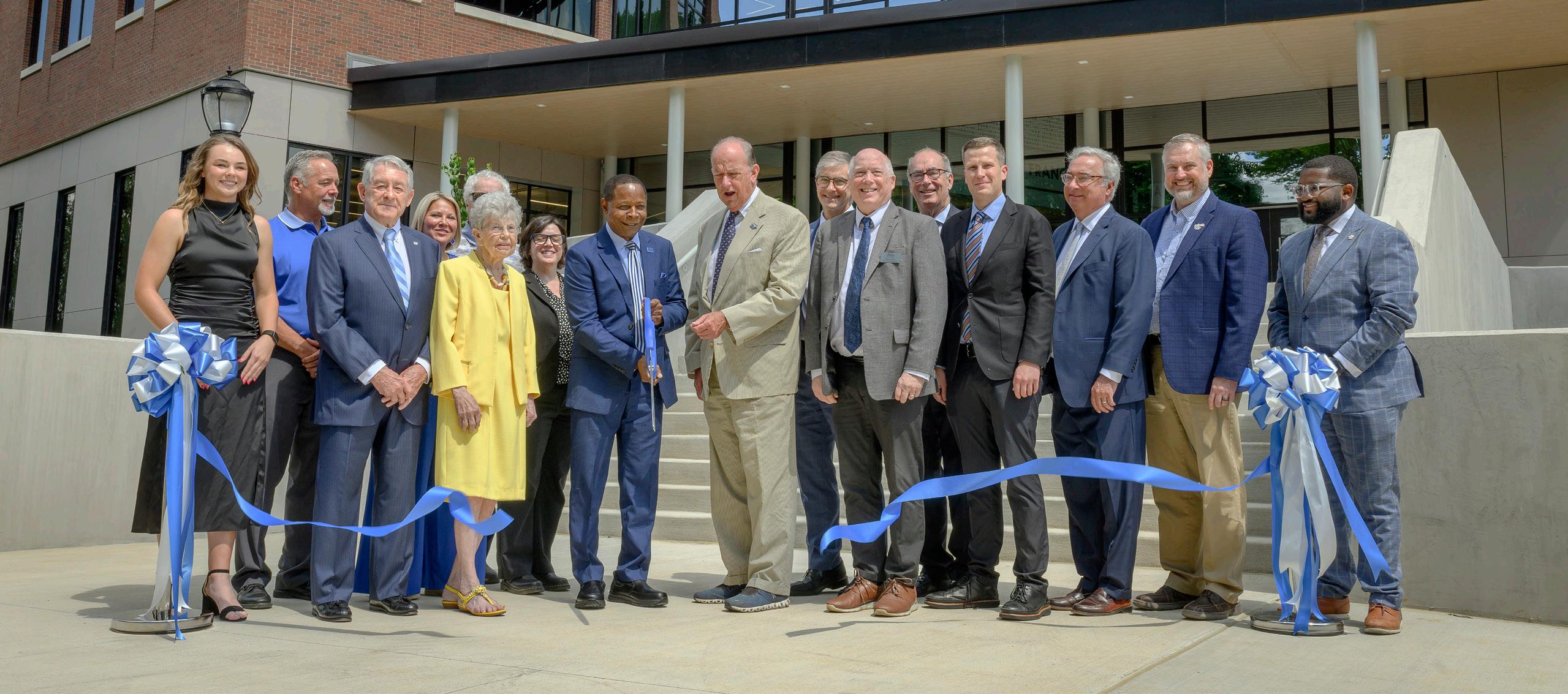
MTSU President Sidney A. McPhee (center left) and Board Chair Stephen B. Smith (center right) cut the ribbon at the AEB opening.
they’ve been able to use their degree to get to a spot in the world where they can give back to the University.”
During his time on campus, Patel has embraced every opportunity to learn, serving as a lab assistant and student ambassador for the department. He now helps give tours of the new AEB while also benefitting from scholarships that supported his studies. So too does Hannah Wolfram, a Mechanical Engineering Technology student and recipient of several scholarships.
“Scholarships are life-changing,” Wolfram said. “They’ve propelled me forward, helped me stay committed and focused on school, and made a huge difference for me.”
Now, as she continues her studies in the new building, Wolfram is especially grateful for the gifts that have expanded student access to cutting-edge technology.
“I’m incredibly grateful to be moving forward as the school grows,” she said. “I’m excited to see what we can do with the new resources compared to where we were last semester. This is a big step forward.”
The generosity of families like the McDonalds and the Goulds has created an impact that will serve students for decades to come. For many, that support is the deciding factor in whether they can pursue their college dreams.
Individuals interested in creating a legacy with the Engineering program, can learn more at et.mtsu.edu.
Contact Jared Bryson, development director for the MTSU College of Basic and Applied Science, at 615-898-5003 or jared.bryson@mtsu.edu

Give to Impact Lives
CBAS: Where science meets innovation and prepares tomorrow’s workforce
• 11 departments advancing discovery — from Aerospace and Agriculture to Computer Science, Chemistry, Biology, Physics, and more
• Hands-on learning that transforms classrooms into labs, labs into discoveries, and discoveries into careers
• Nationally recognized programs in Aerospace, Concrete Industry Management, and Mechatronics Engineering
• Breakthrough research in:
quantum materials and workforce development
artificial intelligence, data science, and machine learning
biotechnology and biomedical sciences
environmental science and sustainability
advanced materials and manufacturing
aerospace and aviation innovation

• Industry partnerships that are driving Tennessee’s economic growth and national competitiveness
• Student success focusing on internships, innovative projects, and workforce-ready training
Your gift fuels innovation, research, and the workforce of tomorrow.
Donate now at mtsu.edu/supportcbas

Or mail a check in the envelope inside this magazine


MTSU Aerospace
professor Nate Callender adds a potentially life-saving wrinkle to the pilot literature on “engine-out glide”
Chesley “Sully” Sullenberger was the US Airways captain who guided his Airbus A320 with 155 passengers aboard to a safe landing in the Hudson River on Jan. 15, 2009, after a flock of Canada geese knocked out both of his airplane’s engines.
The feat, remembered as the “Miracle on the Hudson,” made such an indelible impression that Oscar-winning director Clint Eastwood retold the story in a Hollywood movie titled Sully.
In the film, and in real life, Sullenberger adjusted the plane’s pitch to maintain an optimal glide speed, calculating the correct speed and altitude at which to raise the plane’s nose and slow its descent, creating a softer landing.
Sullenberger’s calm calculations under pressure and his deft touch kept the plane from stalling or dropping hard into the water, maintaining level wings, and kept the plane from flipping or breaking up—outcomes that would have no doubt led to loss of life.
A few avionics companies have developed on-board systems to help pilots navigate “engine-out glides” like what Sullenberger faced.
Existing in-cockpit displays provide “glide range rings” that inform pilots how far the aircraft should be able to glide at any given moment, as well as the locations of nearby airports. Developed by tech heavyweights like Garmin and Boeing (ForeFlight), avionics software of this type is now an industry standard.
by Drew Ruble
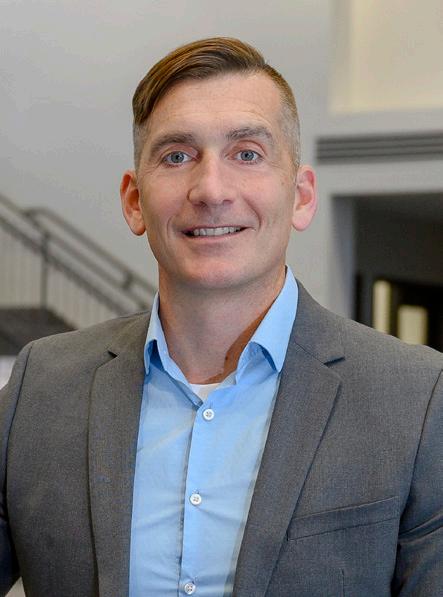
But recently, MTSU professor and associate chair of the MTSU Aerospace Department Nate Callender introduced a way to improve engine-out glide performance that adds a critical new component to the pilot literature. It could prove to be a life-saving development in future flight.
Nate Callender
CRUCIAL CALCULATIONS
Callender made his discovery while working as an expert witness on a court case dealing with a singleengine airplane that lost its engine in flight.
As a part of the court case, Callender used his flighttesting background to design and lead a flight test to determine the aerodynamic performance of this airplane.
He then used that information to make glide-path predictions to the different airports that were available to that airplane at the time of the accident.
In the course of doing those calculations, Callender discovered something novel. Something Callender said pilots don’t know and are not presently taught.
According to Callender, when a pilot loses the engine, making the airplane a glider, the safest landing location may not be straight ahead. A turn will likely be necessary to get there.
How best to turn in an engine-out glide, Callender said, is not taught. Meaning pilots don’t know whether to use a very low bank angle or a really steep bank angle to make the turn.
“I was able to identify the bank angle that gives a pilot the most glide distance when they have to conduct a gliding turn,” Callender said. “Essentially, current, readily available avionics software does not account for the distance that you would lose if you have to turn in the glide.”
To fill this gap, Callender conducted an optimization of gliding turns to safe landing locations that resulted in a set of equations and associated graphs. This provided the optimum bank angles for different directions that a pilot would have to use in a gliding turn (based upon how far they’d have to turn in an emergency engine-out scenario).
“The equations take into account how high the aircraft is above the ground, its altitude, the glide performance of the airplane (glide ratio), and the amount of turn required,” Callender said. “So, let’s say the safe landing location is directly to your right or left, requiring a 90-degree heading change. Or, if it’s directly behind you, that’s a 180-degree heading change. The inputs into the equation are: how far you have to turn, how high you are when you start, and the airplane’s glide ratio.
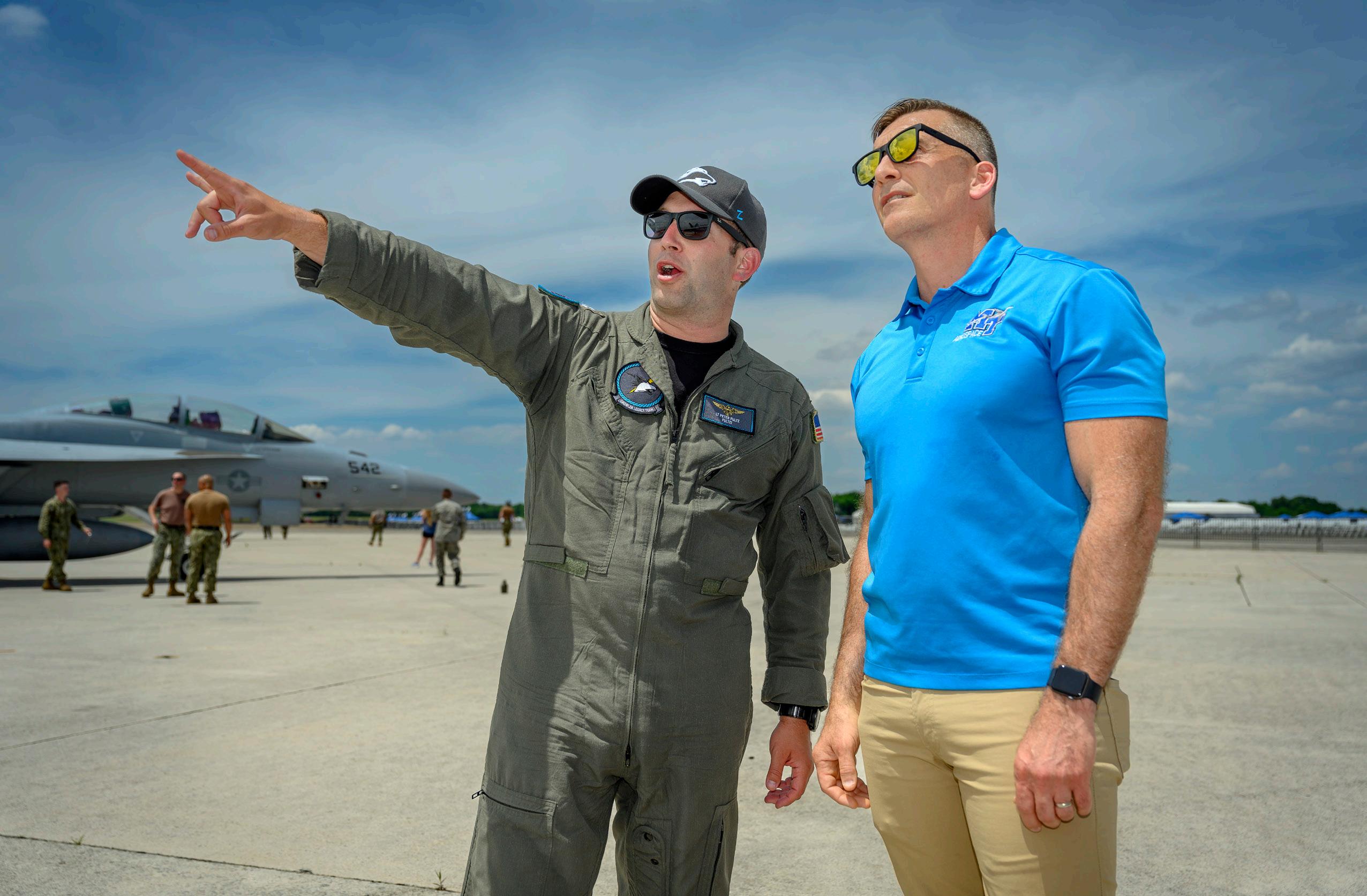

MTSU’s Callender (r) with a Navy pilot

“The lower the bank angle, the better your glide ratio will be. But the radius of your turn will be very large, which means you’ll cover more physical distance, and the whole time you’re losing altitude. So, you steepen the bank angle, which decreases the glide radius and minimizes the time that you’re descending, and it puts you on an intercept course sooner, allowing you to level your wings and get back to the airplane’s wings-level glide ratio.”
Callender said avionics companies could incorporate this information into their software. In the interim, pilots can add this information to their knowledge base.
“It would be a lot to expect a pilot in the cockpit to remember an equation and to do the mental math with complex equations, even on a calculator, in an emergency,” Callender said. “However, you could expect them to know that the optimum bank angle is a variable that you need to think about if you have to turn to different locations in an engine-out glide. And for the most part, the more turn that’s required, the steeper the bank angle needs to be.”
Callender has published this information in multiple places, as well as presented his results at various conferences including at the National Association of Flight Instructors (NAFI), the University Aviation Association, the Society of Flight Test Engineers, and the National Training Aircraft Symposium, a conference attended by a mix of practical aviation trainers and academic departments like MTSU’s.
NAFI president Paul J. Preidecker said Callender’s recent presentation at the NAFI annual conference was very well received.
“Dr. Callender presented detailed mathematical data into easy-to-understand conclusions and recommendations for best practices. His focus on safety and risk mitigation aligned very well with the conference,” Preidecker said.
“Dr. Callender offered to send attendees his Glide Optimization Tool, which is a practical, easy-to-use tool to help determine glide performance in an engine-out situation. Several pilots requested this information.”
Representatives of both Boeing and Garmin were in attendance at Callender’s presentation to engineers. He has encouraged each company to consider this potential enhancement to their software.
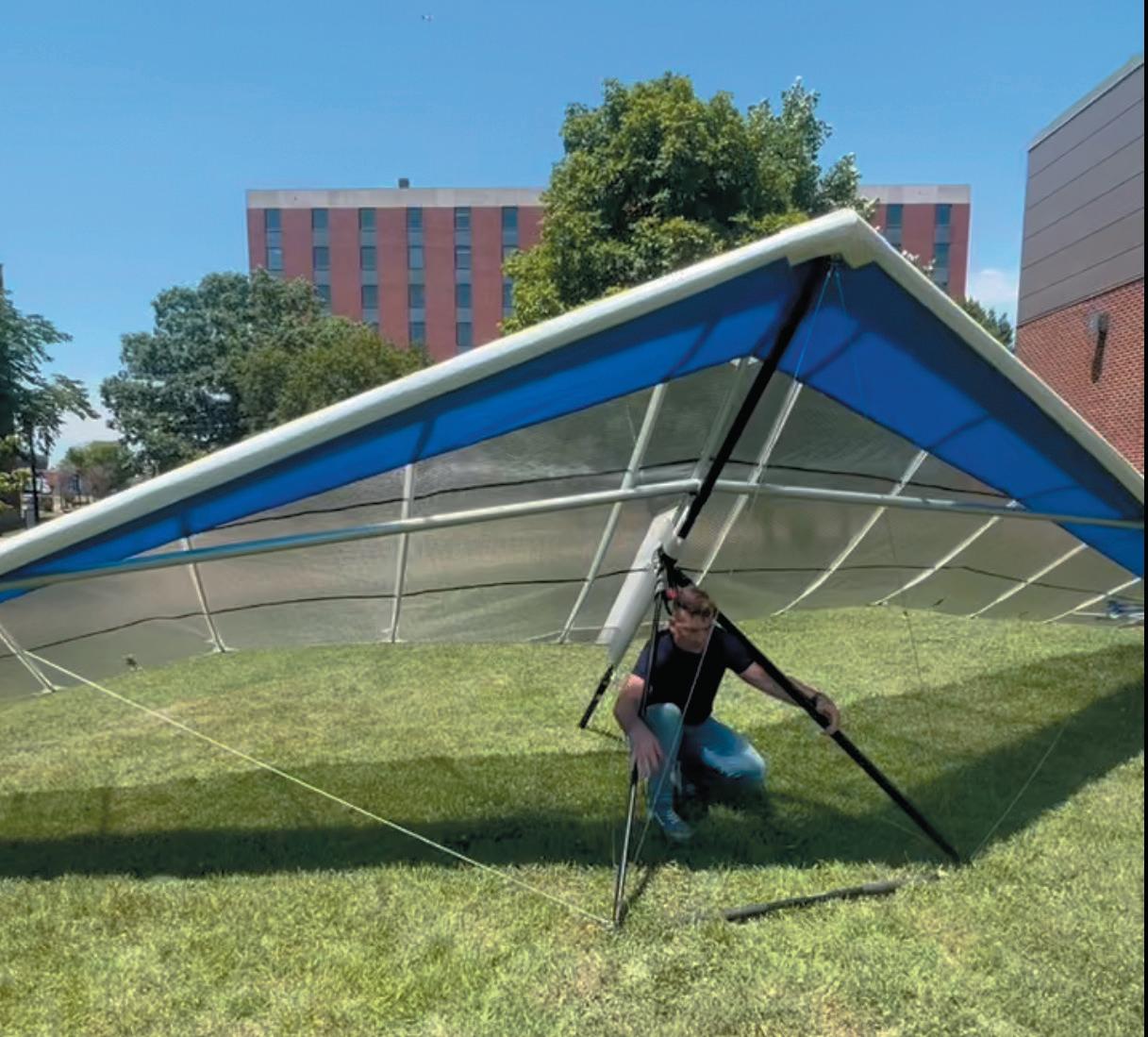
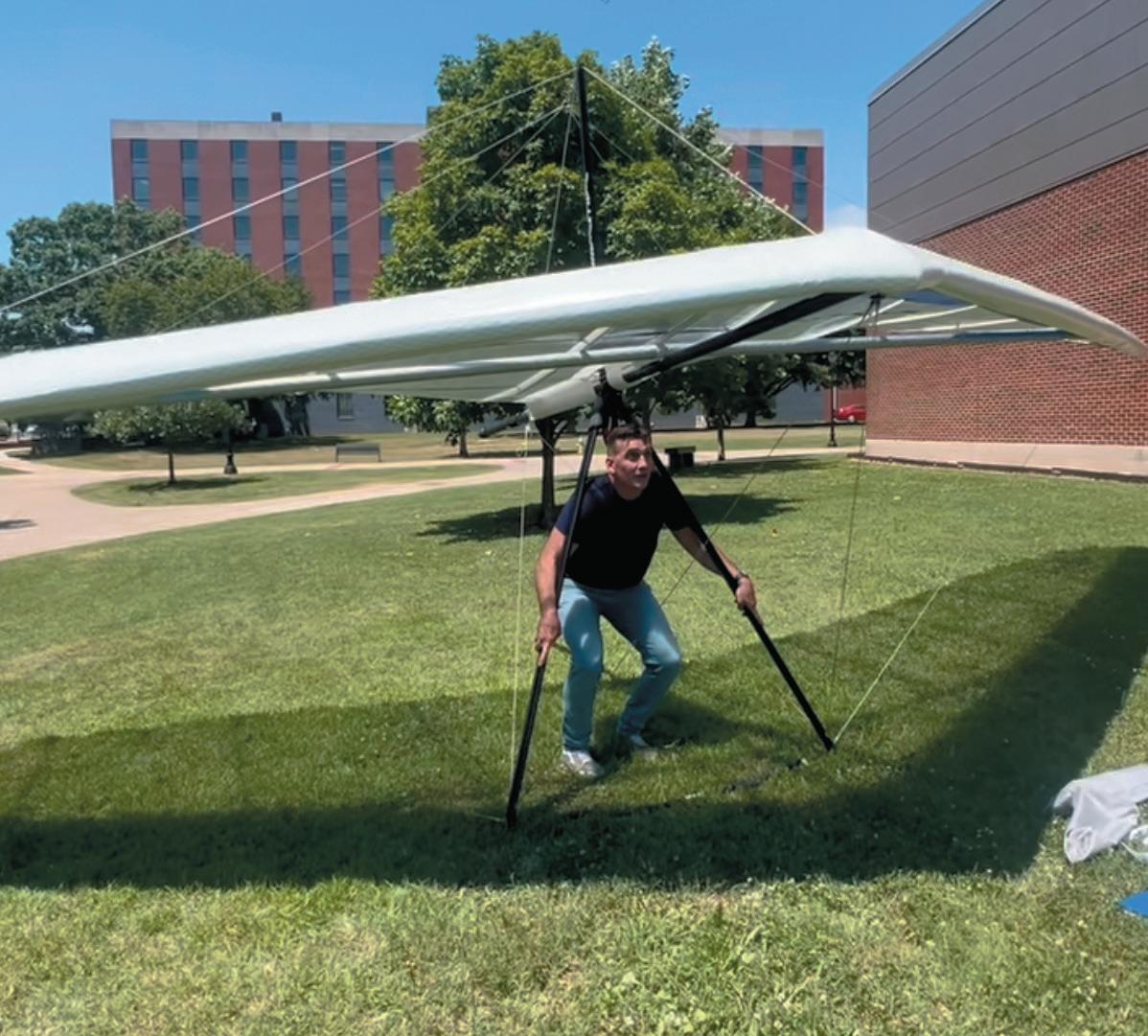
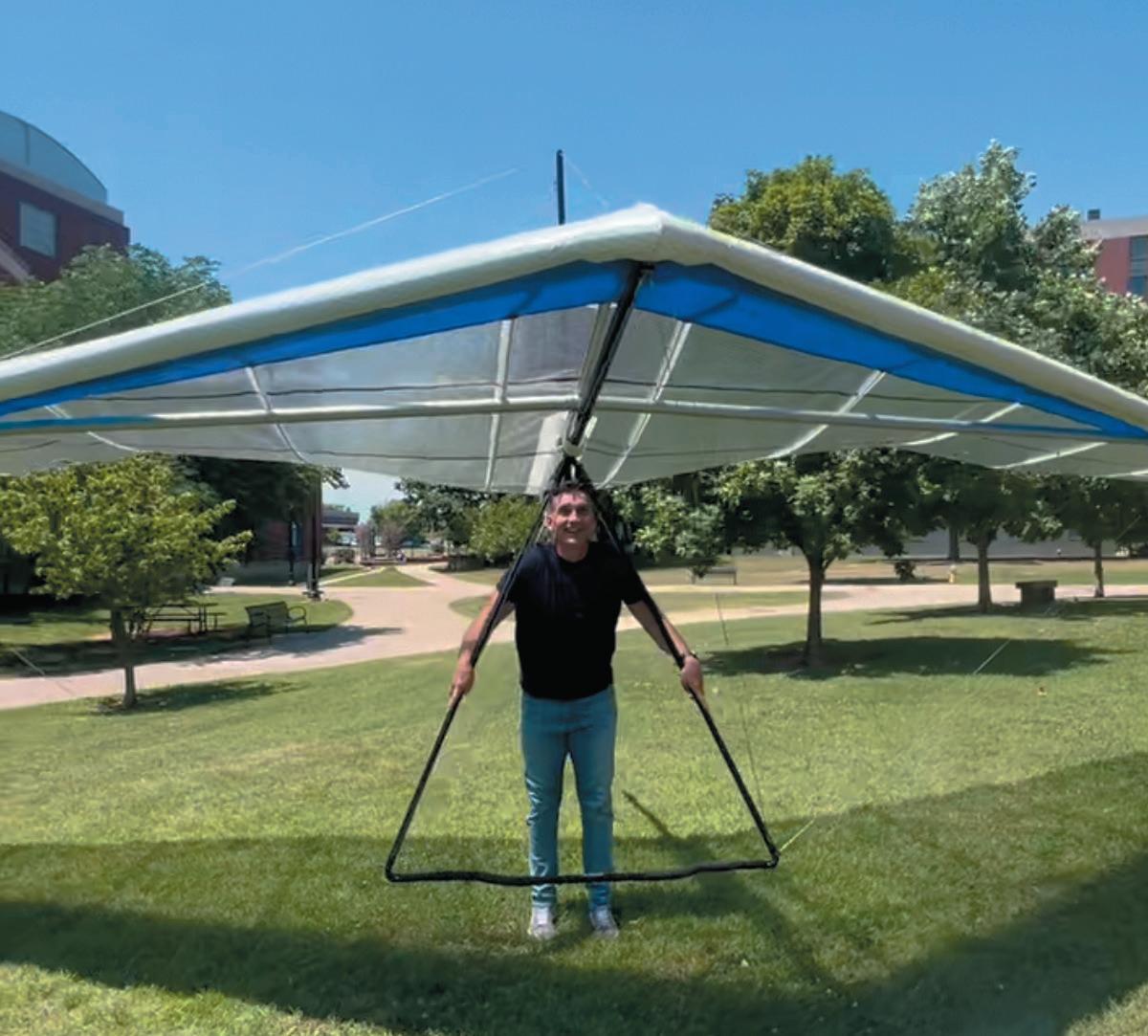
A LIFE IN GLIDE
That Callender would discover something new regarding engine-out glide should come as no surprise given his background.
Callender’s first experience as an actual pilot was not in a plane but in an unpowered glider, learning to stay aloft and to monitor the air and ground for potential sources of lift—whipping winds moving upward in waves.
Callender would eventually become a pilot, earning his master’s in Aviation Systems and his Ph.D. in Engineering Science from the University of Tennessee
Space Institute. Prior to joining academia, he worked for the Army technical test center in Fort Rucker, Alabama, doing flight testing for the Army primarily in helicopters (the attack division, responsible for flight tests on Apaches, Blackhawks, Chinooks, and others).
Even to this day, though, gliding is a big part of his life— and academic pursuit.
For the last 20 years, one of the courses that he regularly teaches is Aircraft Performance. Glide performance is a portion of the curriculum.
“In my opinion, it’s one of the most important classes because glide performance is what pilots need to think


about when things go wrong,” Callender said. “Because in airplanes, especially single-engine airplanes, like what most of our students learn in at MTSU, if you lose the engine, you become a glider.”
Callender also teaches a course called Theory of Flight, teaching the basics behind how aircraft fly, how engines work, and the math and physics involved. He even wrote a grant for that course that enabled him to begin providing students hang-glider training, which he taught near Lookout Mountain in southeast Tennessee.
Callender’s fascination with gliding perhaps stems from what he describes as his earliest aviation memory.
“I had a dream when I was a kid where I was running on the beach and I put my arms out and I took off and I was just flying over the beach,” he said.
Born and raised in west Tennessee in a little town called Halls, Callender’s first actual taste of flight came when he was just 2 years old.
He doesn’t remember it, but his family told him the story. His hometown was home to an abandoned World War II Army air base. It still has one active runway you can fly into today. Callender’s grandparents and greatgrandparents both lived near the property where the air base used to be. They had farmland there, and one

of the abandoned concrete runways basically was the road that went past the front of their houses. There was a missionary pilot who flew in and gave him a ride in his airplane.
“That’s what I’ve been told is my first airplane experience,” Callender said. “But from a young child, I’ve always liked and thought about aviation.”
These days, Callender’s thinking about aviation is leading to enhanced safety measures.
Air travel keeps getting safer, according to a study by Massachusetts Institute of Technology researchers. The risk of a fatality from commercial air travel was 1 per every 13.7 million passenger boardings globally in the 2018–22 period—a significant improvement from 1 per 7.9 million boardings in 2008–17 and a far cry from the 1 per every 350,000 boardings that occurred in 1968–77, the study found.
Nevertheless, safety improvements in flight are always welcomed, and commonly stem from new technologies. Research like Callender’s has the potential to lead to technological advancements that improve aviation performance—and save lives.
Basic Highlights
A Test of Endurance
Fifteen teams and 130 students worked 36 hours nonstop at the 10th annual MTSU Computer Science Department HackMT hackathon Jan. 31–Feb. 2. With industry professionals serving as mentors—some of them alumni—the teams invented new web and computer applications, games, and more.
Computer Science, Mathematics, Mechatronics Engineering, and Computer Information Systems students participated. Sponsors included Asurion, CAT Financial, Bondware, and CGI.
Judges awarded juniors Gavin Liles and Noah Smith scholarships.
One of several Mechatronics Engineering students participating in the event, Bereket Tagistesillassie of Murfreesboro was among 14 students and mentors with the “AudiPy” team on a successful math-oriented project providing data analysis for audio.
“It was a fully functional Python library for people to download,” said Tagistesillassie, 21, who graduated in May. He added that he was “able to get some sleep and make sure things were running properly.”
Brothers Thomas, 17, and Rafaiel Abdelmaseh, 15, of Smyrna were both freshmen—Thomas at MTSU, majoring in Mechatronics Engineering, and Rafaiel at Stewarts Creek High School in Smyrna. Their project, titled “Robotic Hand Assistant,” created a model device “to help elderly and disabled people in their day-to-day lives or their chores,” Thomas Abdelmaseh said.
“The robot will have multiple sets of hands or accessories that are interchangeable for different tasks, and the robot will change it by itself. The person will instruct the robotic arm where to go. The robot will also have sensors that will be used for obstacle avoidance, but it will also use AI (artificial intelligence) to map out the house, and the robot will remember where different rooms are.”
Mentors from Nashville-based LKQ led one team in its facial recognition project titled “FaceOff.” The team earned first place in the judges’ voting.
“We overcame a lot of challenges,” said Andrew Walker, 22, a senior Computer Science major from Murfreesboro. LKQ’s Fred Nelson said it was “a web app that tracks your facial emotions and displays them.”
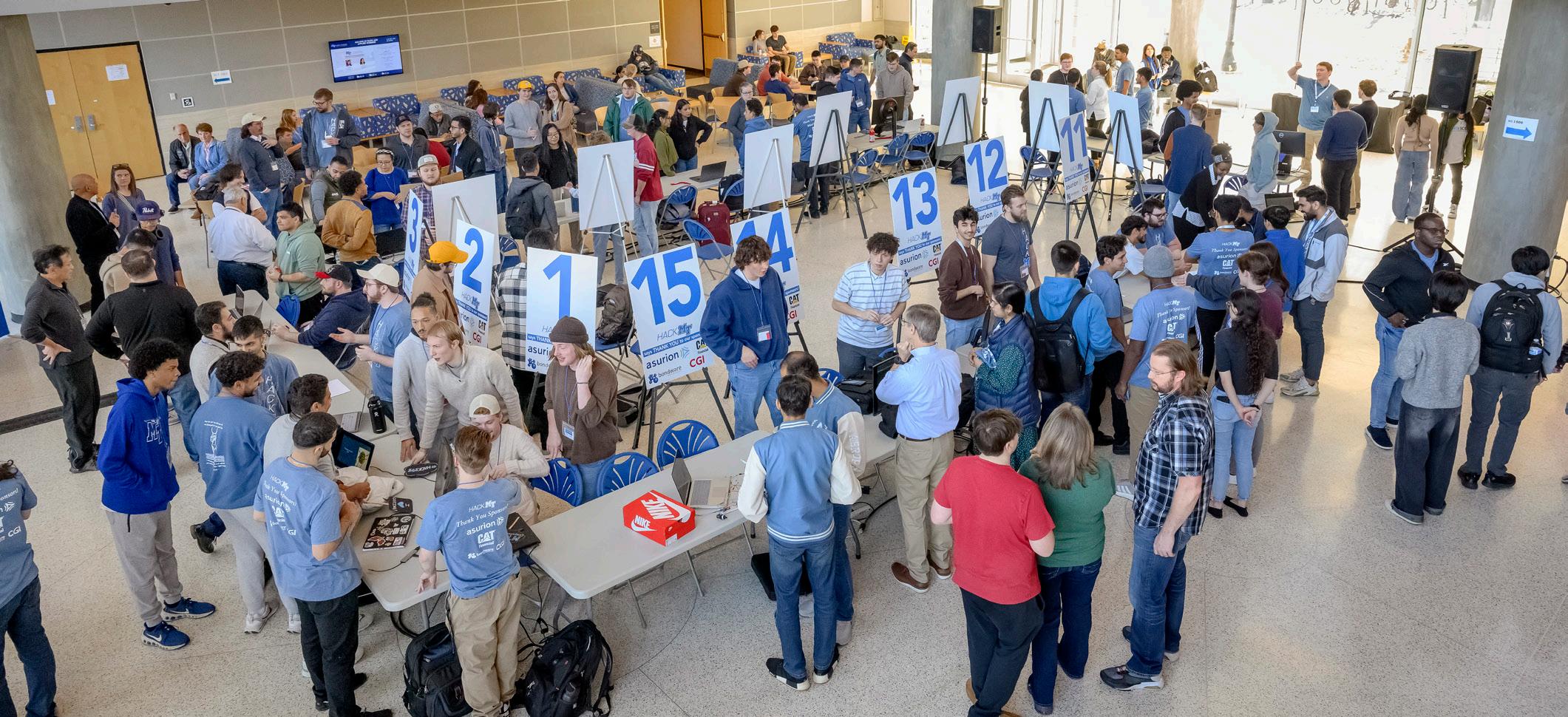
Lifting Off
The Aerospace Department’s new home at the Shelbyville Municipal Airport is taking shape, with construction progressing toward a fall 2027 completion target. The $62.2 million project spans about 20 acres and will include a 28,000-square-foot hangar for MTSU’s fleet of aircraft, plus 50,000 square feet of space for classrooms, a dispatch center, faculty and staff offices, and more.
MTSU has already begun flight training at the Shelbyville airport, though it won’t move the bulk of its fleet until later. The expansion to Shelbyville was a necessary step for the department, which is growing and needs more space than Murfreesboro’s airport can provide.
Aerospace is the largest major at MTSU, with most of its 1,200-plus students in the Professional Pilot concentration.

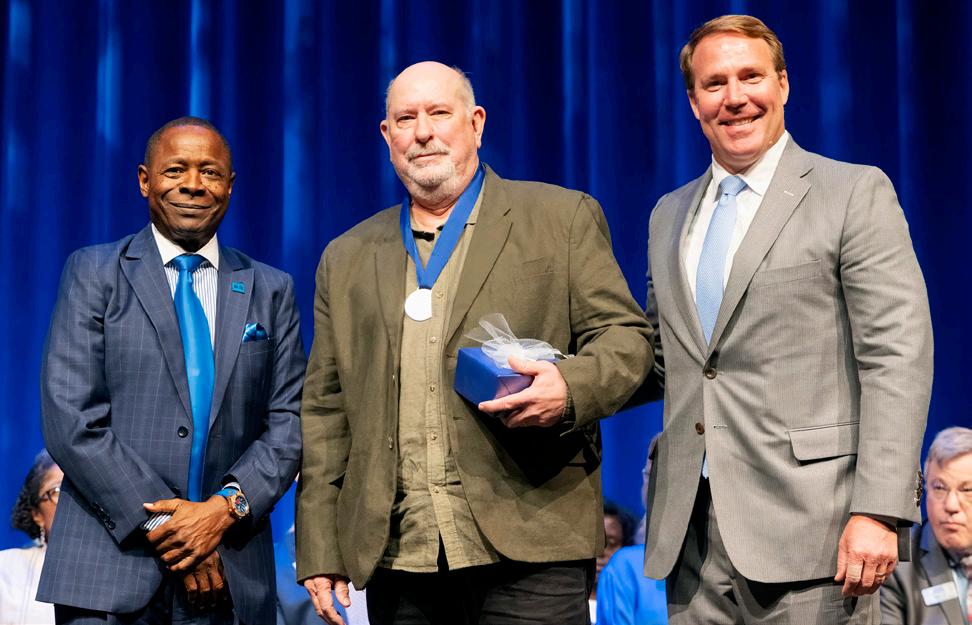
First in Flight
Aerospace Professor Paul Craig was honored with the 2024 Career Achievement Award at the annual Fall Faculty and Staff Meeting and State of the University Address held in Tucker Theatre on campus.
Craig was the University’s first flight instructor for MTSU’s renowned aviation training program.
Aside from his time in the cockpit, Craig has authored 15 books on aviation safety and flight training, has also worked for NASA, and received numerous university and industry awards.
Venturing Out
For the seventh consecutive year, the Department of Aerospace took True Blue to Wisconsin for the EAA AirVenture in 2025, connecting with alumni and industry partners during the world’s largest gathering of aviation enthusiasts. The massive weeklong event, which attracts more than a half a million people and 10,000-plus aircraft annually, is held in Oshkosh, Wisconsin.
As a premier aviation training university, it’s important that MTSU be not only present but active at the world’s greatest aviation celebration. EAA gives MTSU the opportunity to connect not only with industry leaders, but also many MTSU alums.
MTSU officials annually meet with employers of aerospace graduates—Delta, Southwest, FedEx, Endeavor Air, and Republic Airlines, among others. They also meet with executives from manufacturers like Diamond, Piper, and Cirrus.

Not Horsing Around
MTSU’s stock horse team was crowned the 2025 National Intercollegiate Ranch and Stock Horse Association Division II Champion. Students competed in the versatility ranch horse events, showcasing their talents in ranch reining, cow work, ranch trail, and ranch riding. Team members were Marci Leath, Kenlee West, Alyssa Davis, Keira Wagner, and Simone Allen. MTSU also earned national runner-up honors in the Intercollegiate Horse Shows Association’s Western competition.

Head for the Hill
Seven MTSU undergraduate student researchers were among nearly 60 from nine Tennessee universities attending the annual Posters at the Capitol at the Tennessee Capitol in Nashville this past spring.
Hosted by MTSU and the Tennessee STEM Education Center since 2006, Posters at the Capitol showcases research being conducted by undergraduates from Memphis to Johnson City. The event exposes state legislators to the student researchers and the students to their legislators.
Participating MTSU students were Edwin Walck, Izzy Jacober, Rashieq Cockerham, Isaac Puckett, Ananya Arcot, Shelby Mayhut, and Esme’ Keszler.

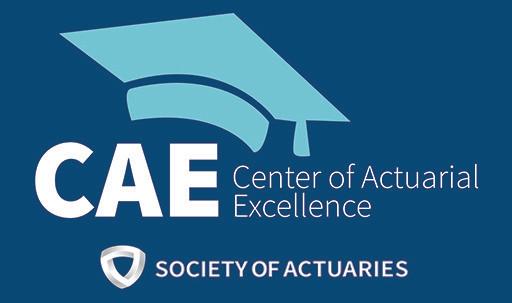
Global Recognition
Actuaries are the go-to problem solvers for businesses that need to manage financial risk. And every business manages financial risk. MTSU is the only university in Tennessee that offers actuarial science coursework for both undergraduate and graduate degrees.
In 2024, MTSU was recognized as a Society of Actuaries Center of Actuarial Excellence, placing it among the top 43 schools in the world. Combine that with the Gold Level Recognition given by the Casualty Actuarial Society, another major actuarial society. MTSU is among only a dozen schools in the world with both these recognitions.
Elite Engineering
Vishwas Bedekar, an MTSU associate professor, was awarded the same national honor for the second time in three years. Bedekar, coordinator of the Mechanical Engineering Technology concentration in the Engineering Technology program, was named one of eight Society of Manufacturing Engineers Distinguished Faculty Advisor Award winners for 2024. Bedekar’s research focuses on energy-harvesting materials and manufacturing processes. An author of more than 30 publications, he also holds a U.S. patent.

A Space Odyssey
Geosciences Department students Emily Therrell, Lula Baldriche, and Trey Littrell were among a dozen participants sharing their NASA-funded research as part of the Tennessee Space Grant Consortium during the Tennessee Geographic Information Council Conference in April 2025.
“Flooding Analysis of the MTSU Campus,” “Analysis of Urban Heat Locations in Nashville,” “Geospatial Insights on Water Quality in Murfreesboro,” and “Lights in the Dark: Tracking Urban Light Pollution in Nashville” were among the semester- and year-long projects.
Their session, held at the Embassy Suites in Murfreesboro, showcased student research and three-minute presentations supported by an initiative called Exploring Earth: A NASASupported Geospatial Learning Experience.
Racha El Kadiri, an associate professor in Geosciences, was the project lead.
Ladies in Concrete
The Concrete Industry Management program hosted more than 320 area middle and high school girls in May at the second annual Ladies in Concrete Workshop, showcasing potential careers in a field that has traditionally been dominated by men. Building on last year’s successful event at the School of Concrete and Construction Management Building, this year’s workshop drew even more girls and young women to campus.
Participants got an up-close view of different parts of the concrete industry through hands-on workshops demonstrating common things seen on a job site. The event provided eight workstations—heavy equipment, hand tools, mix design, pre-casting, finishing, masonry, 3D printing, and welding— offering immersive experiences with professional equipment, all hosted by 17 different alumni and local industry partners.

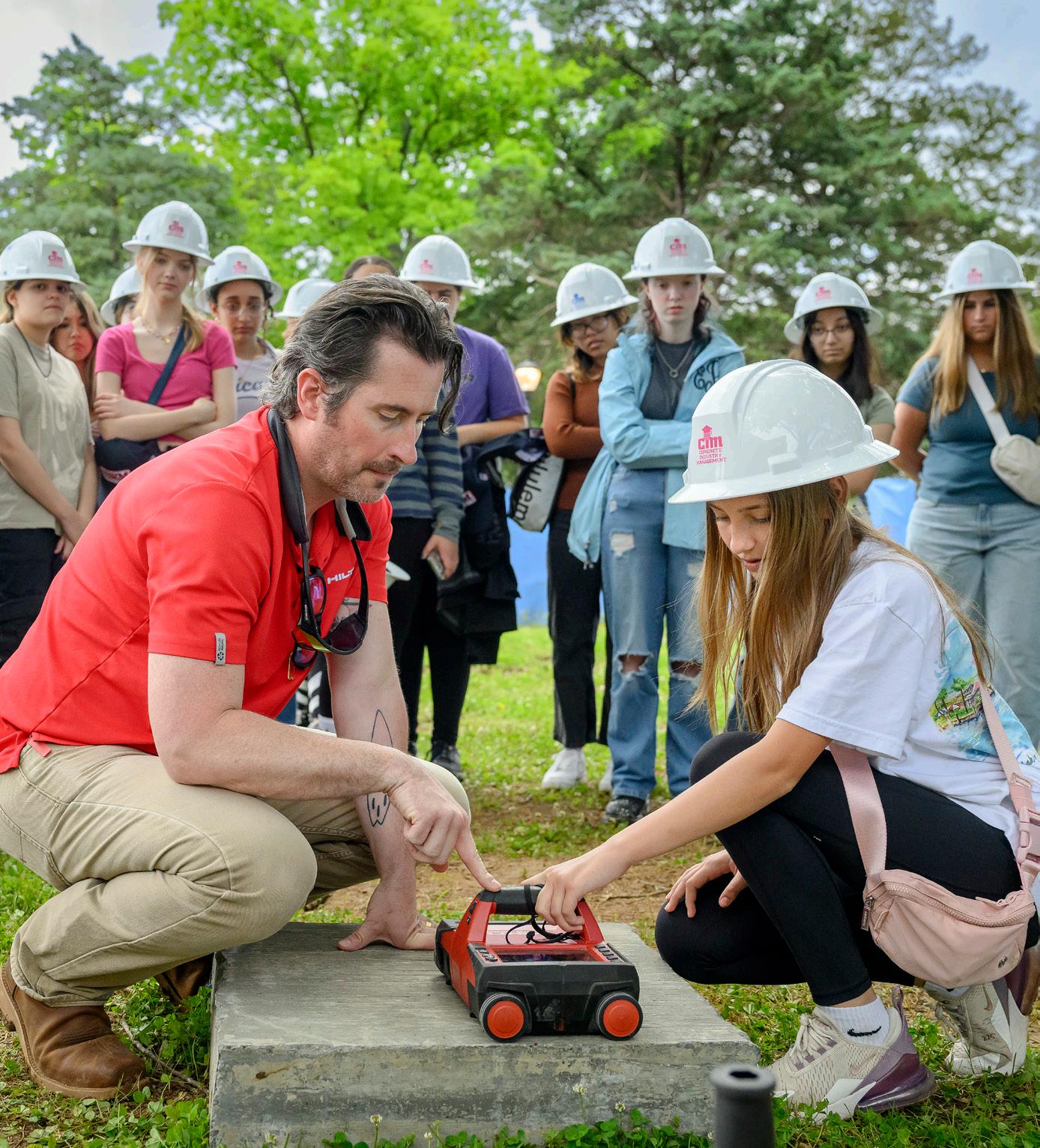
Gold Standard
Sophomore and Honors Buchanan Fellow Ariel Nicastro was named a 2024 Goldwater Scholar—one of only 10 students from Tennessee institutions to receive the award that year.
Nicastro, a Physics major earning the MTSU 2025 Provost’s Award, was also among three Middle Tennessee State University students awarded the Benjamin A. Gilman International Scholarship to study abroad this year.. The U.S. Department of State awarded the prestigious scholarship to approximately 1,600 undergraduate students from all 50 states, the District of Columbia, and Puerto Rico during the fall 2024 cycle.
Honors student and Biochemistry major Isaac Puckett was among just 441 students nationwide named Goldwater Scholars in 2025.
The Goldwater Scholarship, one of the oldest and most prestigious national scholarships in the U.S., financially supports college sophomores and juniors who show exceptional promise of becoming this nation’s next generation of research leaders in the fields of natural sciences, engineering, and mathematics.
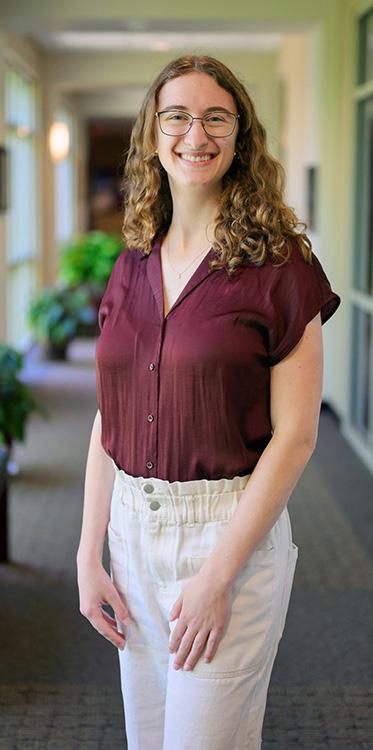
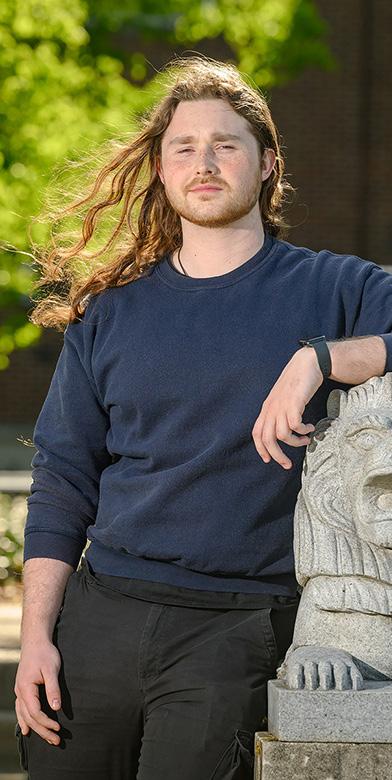
Puckett is MTSU’s seventh consecutive Goldwater recipient. The University has had 12 since its first recipient in 2007, in addition to eight students’ receiving honorable mentions. These honors highlight the strength of MTSU’s research programs and the University’s ability to prepare students for competitive national awards.
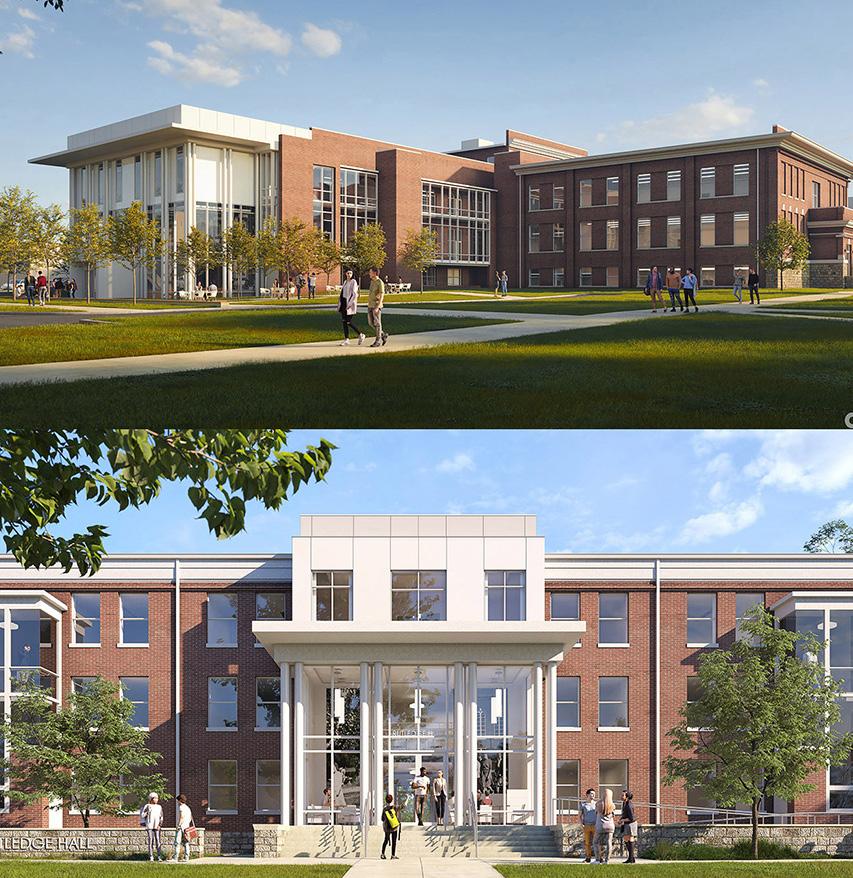
What’s Old Is New Again
Two of MTSU’s original buildings—Kirksey Old Main and Rutledge Hall—are undergoing a $54.3 million renovation. Not to worry: The work will preserve KOM’s iconic columns.
President Sidney A. McPhee said the project “will restore KOM to its former glory” by returning blocked-up windows to the original auditorium, exposing original steel trusses, restoring hardwood floors, and creating a new lobby to provide accessible entry. Mathematics, Computer Science, and Data Science will remain in KOM, while Rutledge will house University Studies. Completion is scheduled for summer 2026.
CBAS Dean Greg Van Patten called the KOM project “a bridge from MTSU’s origins to its future. . . . Mathematics is a required pillar of every single undergraduate degree we confer, and it is a foundational discipline for every discipline in our college. Computer science and data science represent modern frontiers of technology.”
Rendering of new KOM rear entrance
Rutledge renovation rendering
Dollars and Sense
Numerous faculty members at MTSU are focused on research initiatives in the area of science, technology, engineering, and mathematics, collectively known as STEM.
A cohort of MTSU faculty landed a $3 million National Science Foundation (NSF) grant to develop local middle school teachers in STEM subject areas into data science instruction experts who will go on to develop educators in their communities.
Gregory Rushton, director of MTSU’s Tennessee STEM Education Center, leads that five-year grant project in collaboration with Ryan “Seth” Jones, Kevin Krahenbuhl, and Keith Gamble.
Separately, three MTSU professors were awarded their own $1.2 million NSF grant to advance research in improving the teaching of STEM fields in general.
Grant Gardner, Sarah Bleiler-Baxter, and Rushton (l–r in top photo below) head that research project.
MTSU is designated a R2 doctoral university with high research activity by the Carnegie Classification of Institutions of Higher Education. This elite status places MTSU among a select group of only 3% of institutions nationwide.
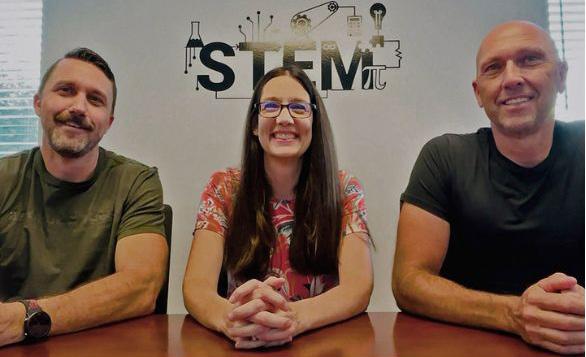
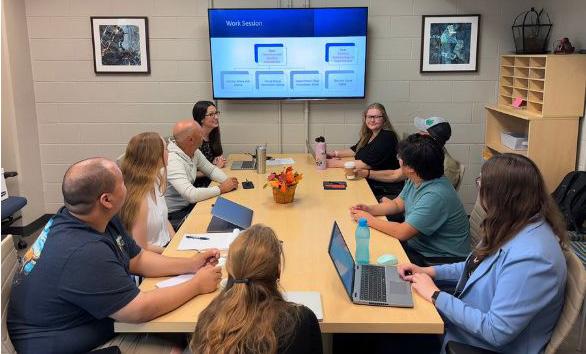

On Patrol
The national commander of Civil Air Patrol (CAP), the volunteer civilian auxiliary of the U.S. Air Force, paid a visit to MTSU in 2024 to celebrate the decade-long partnership between the two institutions.
Maj. Gen. Regena Aye, CAP’s highest-ranking officer, leads CAP’s nearly 70,000 members across the United States in fulfilling the nonprofit organization’s three primary programs: emergency services, cadet programs, and aerospace education.
Aye, along with Col. Jeffery Garrett, commander of CAP’s Southeast Region, which includes Tennessee, were guests of retired Army Lt. Gen. Keith Huber, MTSU’s senior adviser for veterans and leadership initiatives. They toured the Charlie and Hazel Daniels Veterans and Military Family Center, where Huber briefed the officers about MTSU’s commitment to helping veterans, both on and off campus.
Huber honored Aye with the installation of a commemorative brick at MTSU’s Veterans Memorial, located in front of the Tom Jackson Building.
In its role as the Air Force auxiliary, CAP also is a member of the Total Force, filling a critical role in defense support of civil authorities that includes preserving life, relieving suffering, and providing training support. Last fall, for example, CAP aerial crews flew emergency service missions over areas impacted by hurricanes Helene and Milton.
MTSU and CAP have been partners in aerospace education for cadets since 2014. Since 2017, MTSU has hosted CAP’s National Cadet Engineering Technology Academy, which attracts youth from across the nation to the campus.
1301 E. Main St.
Murfreesboro TN 37132

GRADUATE SCHOOL WITHIN YOUR REACH
Advance your career with affordable and flexible options
MASTER’S PROGRAMS
Actuarial Science
Aeronautical Science
Biology
Biomedical Sciences
Biostatistics
Biotechnology
Chemistry Analytics
Chemistry
Computer Science
Concrete Industry Management
Data Science
Engineering Management
Engineering Technology
Fermentation Science
Geosciences
Health Care Informatics
Horse Science
Mathematics
DOCTORAL PROGRAMS
(No master’s required)
Computational and Data Science
Mathematics and Science Education
Molecular Biosciences
